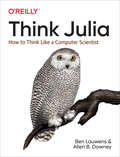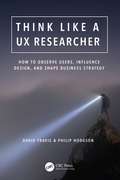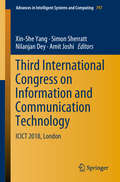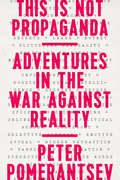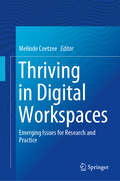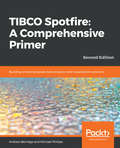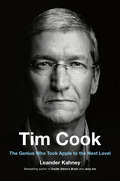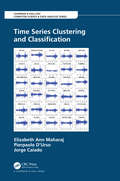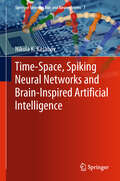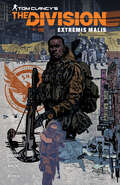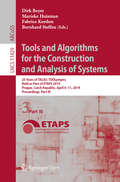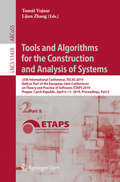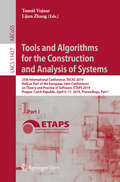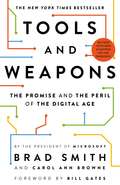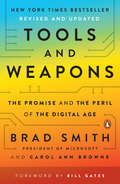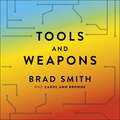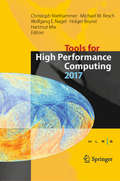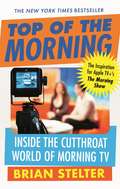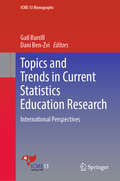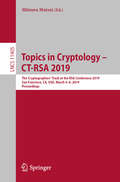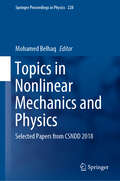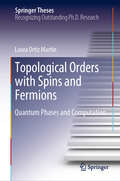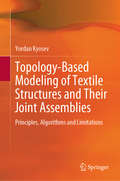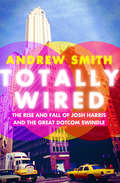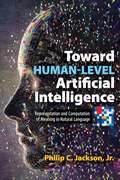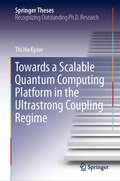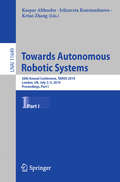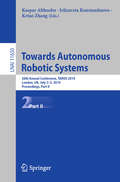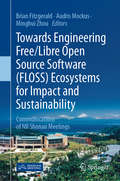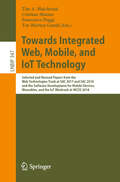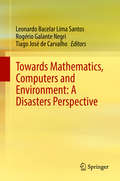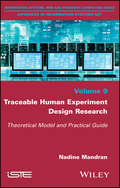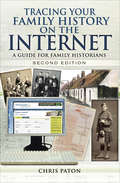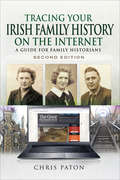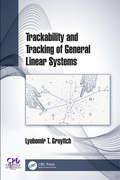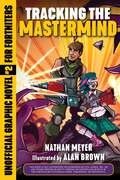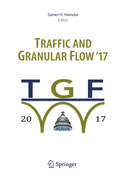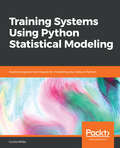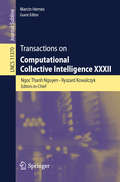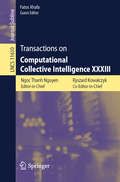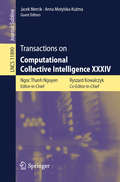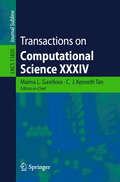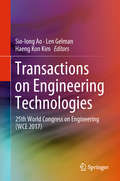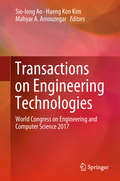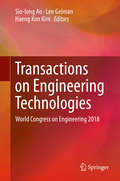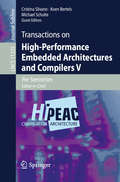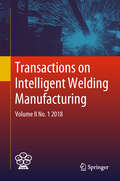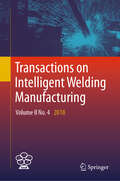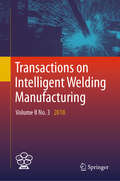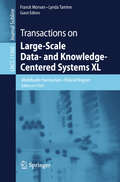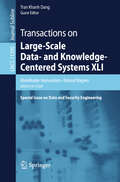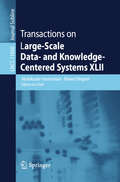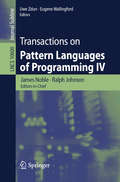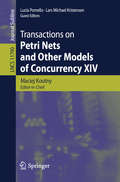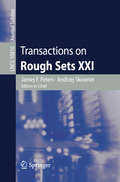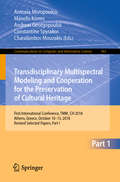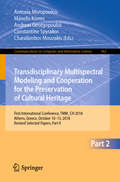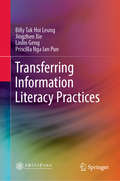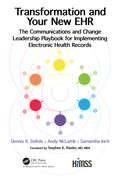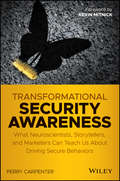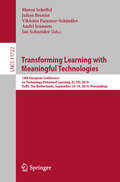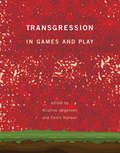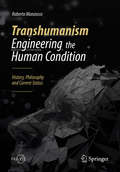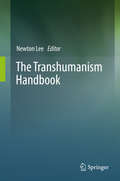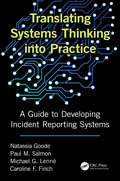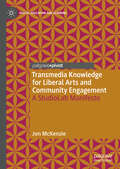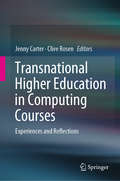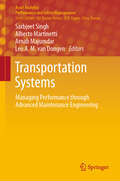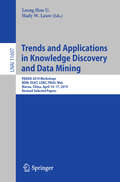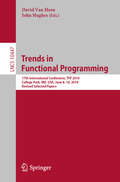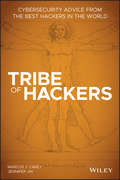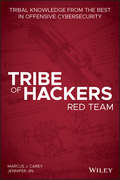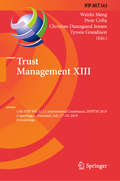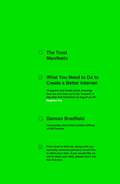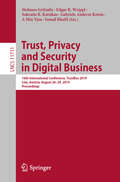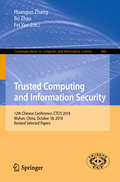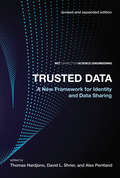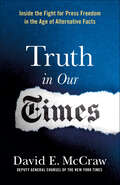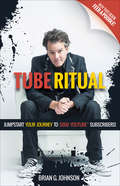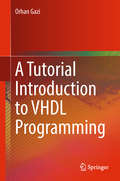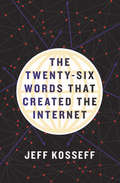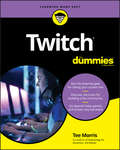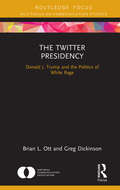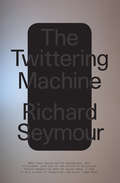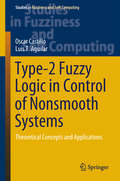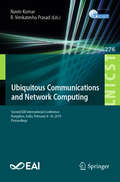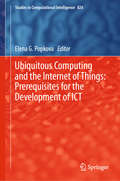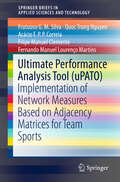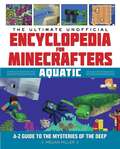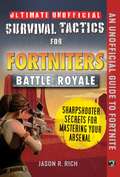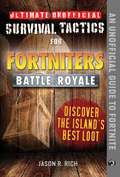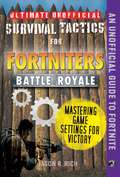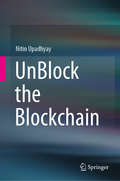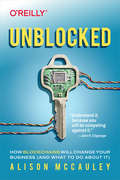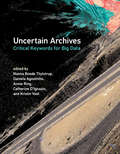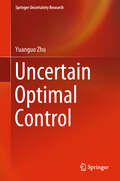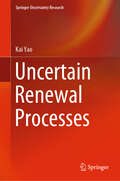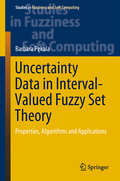- Table View
- List View
Think Julia: How to Think Like a Computer Scientist
by Allen B. Downey Ben LauwensIf you’re just learning how to program, Julia is an excellent JIT-compiled, dynamically-typed language with a clean syntax. This hands-on guide uses Julia (version 1.0) to walk you through programming one step at a time, beginning with basic programming concepts before moving on to more advanced capabilities, such as creating new types and multiple dispatch.Designed from the beginning for high performance, Julia is a general-purpose language not only ideal for numerical analysis and computational science, but also for web programming or scripting. Through exercises in each chapter, you’ll try out programming concepts as you learn them.Think Julia is ideal for students at the high school or college level, as well as self-learners, home-schooled students, and professionals who need to learn programming basics.Start with the basics, including language syntax and semanticsGet a clear definition of each programming conceptLearn about values, variables, statements, functions, and data structures in a logical progressionDiscover how to work with files and databasesUnderstand types, methods, and multiple dispatchUse debugging techniques to fix syntax, runtime, and semantic errorsExplore interface design and data structures through case studies
Think Like a UX Researcher: How to Observe Users, Influence Design, and Shape Business Strategy
by David Travis Philip HodgsonThink Like a UX Researcher will challenge your preconceptions about user experience (UX) research and encourage you to think beyond the obvious. You’ll discover how to plan and conduct UX research, analyze data, persuade teams to take action on the results and build a career in UX. The book will help you take a more strategic view of product design so you can focus on optimizing the user’s experience. UX Researchers, Designers, Project Managers, Scrum Masters, Business Analysts and Marketing Managers will find tools, inspiration and ideas to rejuvenate their thinking, inspire their team and improve their craft. Key Features A dive-in-anywhere book that offers practical advice and topical examples. Thought triggers, exercises and scenarios to test your knowledge of UX research. Workshop ideas to build a development team’s UX maturity. War stories from seasoned researchers to show you how UX research methods can be tailored to your own organization.
Third International Congress on Information and Communication Technology: ICICT 2018, London (Advances in Intelligent Systems and Computing #797)
by Xin-She Yang Simon Sherratt Nilanjan Dey Amit JoshiThe book includes selected high-quality research papers presented at the Third International Congress on Information and Communication Technology held at Brunel University, London on February 27–28, 2018. It discusses emerging topics pertaining to information and communication technology (ICT) for managerial applications, e-governance, e-agriculture, e-education and computing technologies, the Internet of Things (IOT), and e-mining. Written by experts and researchers working on ICT, the book is suitable for new researchers involved in advanced studies.
This Is Not Propaganda: Adventures in the War Against Reality
by Peter PomerantsevWhen information is a weapon, every opinion is an act of war.We live in a world of influence operations run amok, where dark ads, psyops, hacks, bots, soft facts, ISIS, Putin, trolls, and Trump seek to shape our very reality. In this surreal atmosphere created to disorient us and undermine our sense of truth, we've lost not only our grip on peace and democracy--but our very notion of what those words even mean.Peter Pomerantsev takes us to the front lines of the disinformation age, where he meets Twitter revolutionaries and pop-up populists, "behavioral change" salesmen, Jihadi fanboys, Identitarians, truth cops, and many others. Forty years after his dissident parents were pursued by the KGB, Pomerantsev finds the Kremlin re-emerging as a great propaganda power. His research takes him back to Russia--but the answers he finds there are not what he expected.
Thriving in Digital Workspaces: Emerging Issues for Research and Practice
by Melinde CoetzeeThis edited volume focuses on innovative solutions to the debate on human thriving in the fast emerging technology-driven cyber-physical work context, also called Industry 4.0. The volume asks the important question: How can people remain relevant and thrive in workplaces that are increasingly virtual, technology-driven, and imbued with artificial intelligence? This volume includes two major streams of discussion: it provides multidisciplinary perspectives on what thriving could mean for individuals, managers and organisations in current and future non-linear and Web-driven workspaces. In this context, it points to the need to rethink the curricula of the psychology of human thriving so that it is applicable to Industry 4.0. Second, it discusses the new platforms of learning opening up in organisations and the ways and means with which people's learning practices can be adapted to changing scenarios. Some of these scenarios are: changing job designs and talent requirements; the demand for creativity; the need for virtual teams and intercultural collaborations; and changing emotional competencies. This topical volume includes contributions by scholars from across the world, and is of interest to scholars, practitioners and postgraduate students of psychology, organizational behaviour and human resource management.
TIBCO Spotfire: Building enterprise-grade data analytics and visualization solutions, 2nd Edition
by Michael Phillips Andrew BerridgeCreate innovative informatics solutions with TIBCO SpotfireKey FeaturesGet to grips with a variety of TIBCO Spotfire features to create professional applicationsUse different data and visualization techniques to build interactive analyses.Simplify BI processes and understand data analysis and visualizationBook DescriptionThe need for agile business intelligence (BI) is growing daily, and TIBCO Spotfire® combines self-service features with essential enterprise governance and scaling capabilities to provide best-practice analytics solutions. Spotfire is easy and intuitive to use and is a rewarding environment for all BI users and analytics developers.Starting with data and visualization concepts, this book takes you on a journey through increasingly advanced topics to help you work toward becoming a professional analytics solution provider. Examples of analyzing real-world data are used to illustrate how to work with Spotfire. Once you've covered the AI-driven recommendations engine, you'll move on to understanding Spotfire's rich suite of visualizations and when, why and how you should use each of them. In later chapters, you'll work with location analytics, advanced analytics using TIBCO Enterprise Runtime for R®, how to decide whether to use in-database or in-memory analytics, and how to work with streaming (live) data in Spotfire. You'll also explore key product integrations that significantly enhance Spotfire's capabilities.This book will enable you to exploit the advantages of the Spotfire serve topology and learn how to make practical use of scheduling and routing rules.By the end of this book, you will have learned how to build and use powerful analytics dashboards and applications, perform spatial analytics, and be able to administer your Spotfire environment efficientlyWhat you will learnWork with Spotfire on its web, Cloud, PC, Mac and mobile clientsDeploy Spotfire's suite of visualization types effectively and intelligentlyBuild user-friendly analytics frameworks and analytics applicationsExplore Spotfire's predictive analytics capabilitiesUse Spotfire's location analytics capabilities to create interactive spatial analysesWrite IronPython scripts with the Spotfire APILearn the different ways Spotfire can be deployed and administeredWho this book is forIf you are a business intelligence or data professional, this book will give you a solid grounding in the use of TIBCO Spotfire. This book requires no prior knowledge of Spotfire or any basic data and visualization concepts.
Tim Cook: The Genius Who Took Apple to the Next Level
by Leander KahneyJournalist Leander Kahney reveals how CEO Tim Cook has led Apple to astronomical success after the death of Steve Jobs in 2011. The death of Steve Jobs left a gaping void at one of the most innovative companies of all time. Jobs wasn't merely Apple's iconic founder and CEO; he was the living embodiment of a global megabrand. It was hard to imagine that anyone could fill his shoes--especially not Tim Cook, the intensely private executive who many thought of as Apple's "operations drone."But seven years later, as journalist Leander Kahney reveals in this definitive book, things at Apple couldn't be better. Its stock has nearly tripled, making it the world's first trillion dollar company. Under Cook's principled leadership, Apple is pushing hard into renewable energy, labor and environmentally-friendly supply chains, user privacy, and highly-recyclable products. From the massive growth of the iPhone to lesser-known victories like the Apple Watch, Cook is leading Apple to a new era of success.Drawing on access with several Apple insiders, Kahney tells the inspiring story of how one man attempted to replace someone irreplacable, and--through strong, humane leadership, supply chain savvy, and a commitment to his values--succeeded more than anyone had thought possible.
Time and Causality across the Sciences
by Samantha KleinbergThis book, geared toward academic researchers and graduate students, brings together research on all facets of how time and causality relate across the sciences. Time is fundamental to how we perceive and reason about causes. It lets us immediately rule out the sound of a car crash as its cause. That a cause happens before its effect has been a core, and often unquestioned, part of how we describe causality. Research across disciplines shows that the relationship is much more complex than that. This book explores what that means for both the metaphysics and epistemology of causes - what they are and how we can find them. Across psychology, biology, and the social sciences, common themes emerge, suggesting that time plays a critical role in our understanding. The increasing availability of large time series datasets allows us to ask new questions about causality, necessitating new methods for modeling dynamic systems and incorporating mechanistic information into causal models.
Time Series Clustering and Classification (Chapman & Hall/CRC Computer Science & Data Analysis)
by Elizabeth Ann Maharaj Pierpaolo D'Urso Jorge CaiadoThe beginning of the age of artificial intelligence and machine learning has created new challenges and opportunities for data analysts, statisticians, mathematicians, econometricians, computer scientists and many others. At the root of these techniques are algorithms and methods for clustering and classifying different types of large datasets, including time series data. Time Series Clustering and Classification includes relevant developments on observation-based, feature-based and model-based traditional and fuzzy clustering methods, feature-based and model-based classification methods, and machine learning methods. It presents a broad and self-contained overview of techniques for both researchers and students. Features Provides an overview of the methods and applications of pattern recognition of time series Covers a wide range of techniques, including unsupervised and supervised approaches Includes a range of real examples from medicine, finance, environmental science, and more R and MATLAB code, and relevant data sets are available on a supplementary website
Time-Space, Spiking Neural Networks and Brain-Inspired Artificial Intelligence (Springer Series on Bio- and Neurosystems #7)
by Nikola K. KasabovSpiking neural networks (SNN) are biologically inspired computational models that represent and process information internally as trains of spikes. This monograph book presents the classical theory and applications of SNN, including original author’s contribution to the area. The book introduces for the first time not only deep learning and deep knowledge representation in the human brain and in brain-inspired SNN, but takes that further to develop new types of AI systems, called in the book brain-inspired AI (BI-AI). BI-AI systems are illustrated on: cognitive brain data, including EEG, fMRI and DTI; audio-visual data; brain-computer interfaces; personalized modelling in bio-neuroinformatics; multisensory streaming data modelling in finance, environment and ecology; data compression; neuromorphic hardware implementation. Future directions, such as the integration of multiple modalities, such as quantum-, molecular- and brain information processing, is presented in the last chapter. The book is a research book for postgraduate students, researchers and practitioners across wider areas, including computer and information sciences, engineering, applied mathematics, bio- and neurosciences.
Tom Clancy's The Division: Extremis Malis
by Christofer EmgardThe perfect introduction to the post-pandemic world of Ubisoft's record-breaking video game series, this graphic novel follows Division agent Caleb Dunne from New York City to Washington, D.C. in pursuit of the mysterious woman who murdered his partner.This prequel to Tom Clancy's The Division 2 is a must-have for fans of intrigue and tales of survival.Months after a bioweapon attack devastated New York City, the Division agents are the last hope of a United States struggling to hold itself together. During a mission gone horribly wrong, Division agent Caleb Dunne's partner is gruesomely killed and Dunne vows to track down the mysterious woman responsible. Known only as Mantis, Dunne pursues her to Philadelphia, Fort Meade, and eventually Washington, D.C., enlisting the help of fellow agents Heather Ward and Brian Johnson along the way. Together, this newly-formed group of agents uncover a much larger scheme that poses a grave threat to a nation already on the brink of total collapse.
Tools and Algorithms for the Construction and Analysis of Systems: 25 Years of TACAS: TOOLympics, Held as Part of ETAPS 2019, Prague, Czech Republic, April 6–11, 2019, Proceedings, Part III (Lecture Notes in Computer Science #11429)
by Dirk Beyer Marieke Huisman Fabrice Kordon Bernhard SteffenThis book is Open Access under a CC BY licence. This book, LNCS 11429, is part III of the proceedings of the 25th International Conference on Tools and Algorithms for the Construction and Analysis of Systems, TACAS 2019, which took place in Prague, Czech Republic, in April 2019, held as part of the European Joint Conferences on Theory and Practice of Software, ETAPS 2019. It's a special volume on the occasion of the 25 year anniversary of TACAS.
Tools and Algorithms for the Construction and Analysis of Systems: 25th International Conference, TACAS 2019, Held as Part of the European Joint Conferences on Theory and Practice of Software, ETAPS 2019, Prague, Czech Republic, April 6–11, 2019, Proceedings, Part II (Lecture Notes in Computer Science #11428)
by Tomáš Vojnar Lijun ZhangThis book is Open Access under a CC BY licence. The LNCS 11427 and 11428 proceedings set constitutes the proceedings of the 25th International Conference on Tools and Algorithms for the Construction and Analysis of Systems, TACAS 2019, which took place in Prague, Czech Republic, in April 2019, held as part of the European Joint Conferences on Theory and Practice of Software, ETAPS 2019. The total of 42 full and 8 short tool demo papers presented in these volumes was carefully reviewed and selected from 164 submissions. The papers are organized in topical sections as follows: Part I: SAT and SMT, SAT solving and theorem proving; verification and analysis; model checking; tool demo; and machine learning. Part II: concurrent and distributed systems; monitoring and runtime verification; hybrid and stochastic systems; synthesis; symbolic verification; and safety and fault-tolerant systems.
Tools and Algorithms for the Construction and Analysis of Systems: 25th International Conference, TACAS 2019, Held as Part of the European Joint Conferences on Theory and Practice of Software, ETAPS 2019, Prague, Czech Republic, April 6–11, 2019, Proceedings, Part I (Lecture Notes in Computer Science #11427)
by Tomáš Vojnar Lijun ZhangThis book is Open Access under a CC BY licence. The LNCS 11427 and 11428 proceedings set constitutes the proceedings of the 25th International Conference on Tools and Algorithms for the Construction and Analysis of Systems, TACAS 2019, which took place in Prague, Czech Republic, in April 2019, held as part of the European Joint Conferences on Theory and Practice of Software, ETAPS 2019. The total of 42 full and 8 short tool demo papers presented in these volumes was carefully reviewed and selected from 164 submissions. The papers are organized in topical sections as follows: Part I: SAT and SMT, SAT solving and theorem proving; verification and analysis; model checking; tool demo; and machine learning. Part II: concurrent and distributed systems; monitoring and runtime verification; hybrid and stochastic systems; synthesis; symbolic verification; and safety and fault-tolerant systems.
Tools and Algorithms for the Construction and Analysis of Systems: 25 Years of TACAS: TOOLympics, Held as Part of ETAPS 2019, Prague, Czech Republic, April 6–11, 2019, Proceedings, Part III (Lecture Notes in Computer Science #11429)
by Fabrice Kordon Marieke Huisman Bernhard Steffen Dirk BeyerThis book is Open Access under a CC BY licence. This book, LNCS 11429, is part III of the proceedings of the 25th International Conference on Tools and Algorithms for the Construction and Analysis of Systems, TACAS 2019, which took place in Prague, Czech Republic, in April 2019, held as part of the European Joint Conferences on Theory and Practice of Software, ETAPS 2019. It's a special volume on the occasion of the 25 year anniversary of TACAS.
Tools and Weapons: The Promise and the Peril of the Digital Age
by Brad Smith Carol Ann Browne*THE INSTANT NEW YORK TIMES BESTSELLER AND WORLD ECONOMIC FORUM BOOK CLUB PICK*'A clear, compelling guide to some of the most pressing debates in technology today.' Bill Gates, from the foreword'The de facto ambassador for the technology industry at large.' The New York Times'One of the few executives willing to speak openly about the industry's most vexing issues.' Sunday Times__________Microsoft President Brad Smith operates by a simple core belief: when your technology changes the world, you bear a responsibility to help address the world you have helped create. This might seem uncontroversial, but it flies in the face of a tech sector long obsessed with rapid growth and sometimes on disruption as an end in itself. While sweeping digital transformation holds great promise, we have reached an inflection point. The world has turned information technology into both a powerful tool and a formidable weapon, and new approaches are needed to manage an era defined by even more powerful inventions like artificial intelligence. Companies that create technology must accept greater responsibility for the future, and governments will need to regulate technology by moving faster and catching up with the pace of innovation.In Tools and Weapons, Brad Smith and Carol Ann Browne bring us a captivating narrative from the cockpit of one of the world's largest and most powerful tech companies as it finds itself in the middle of some of the thorniest emerging issues of our time. These are challenges that come with no pre-existing playbook, including privacy, cybercrime and cyberwar, social media, the moral conundrums of artificial intelligence, big tech's relationship to inequality, and the challenges for democracy, far and near. While in no way a self-glorifying "Microsoft memoir," the book pulls back the curtain remarkably wide onto some of the company's most crucial recent decision points as it strives to protect the hopes technology offers against the very real threats it also presents. There are huge ramifications for communities and countries, and Brad Smith provides a thoughtful and urgent contribution to that effort.From Microsoft's President and one of the tech industry's wisest thinkers, a frank and thoughtful reckoning with how to balance enormous promise and existential risk as the digitization of everything accelerates.__________In Tools and Weapons, Brad Smith takes us behind the scenes on some of the biggest stories to hit the tech industry in the past decade and some of the biggest threats we face. From Edward Snowden's NSA leak to the NHS WannaCry ransomware attack, this book is essential reading to understand what's happening in the world around us.If you watched Inside Bill's Brain: Decoding Bill Gates on Netflix, you will find Tools and Weapons equally fascinating. 'This is a colourful and insightful insiders' view of how technology is both empowering us and threatening us. From privacy to cyberattacks, this timely book is a useful guide for how to navigate the digital future.' Walter Isaacson, bestselling author of Steve Jobs
Tools and Weapons: The Promise and the Peril of the Digital Age
by Brad Smith Carol Browne<P><P>From Microsoft's president and one of the tech industry's broadest thinkers, a frank and thoughtful reckoning with how to balance enormous promise and existential risk as the digitization of everything accelerates.Microsoft President Brad Smith operates by a simple core belief: When your technology changes the world, you bear a responsibility to help address the world you have helped create. <P><P>This might seem uncontroversial, but it flies in the face of a tech sector long obsessed with rapid growth and sometimes on disruption as an end in itself. While sweeping digital transformation holds great promise, we have reached an inflection point. The world has turned information technology into both a powerful tool and a formidable weapon, and new approaches are needed to manage an era defined by even more powerful inventions like artificial intelligence. <P><P>Companies that create technology must accept greater responsibility for the future, and governments will need to regulate technology by moving faster and catching up with the pace of innovation. <P><P>In Tools and Weapons, Brad Smith and Carol Ann Browne bring us a captivating narrative from the cockpit of one of the world's largest and most powerful tech companies as it finds itself in the middle of some of the thorniest emerging issues of our time. These are challenges that come with no preexisting playbook, including privacy, cybercrime and cyberwar, social media, the moral conundrums of artificial intelligence, big tech's relationship to inequality, and the challenges for democracy, far and near. <P><P>While in no way a self-glorifying "Microsoft memoir," the book pulls back the curtain remarkably wide onto some of the company's most crucial recent decision points as it strives to protect the hopes technology offers against the very real threats it also presents. There are huge ramifications for communities and countries, and Brad Smith provides a thoughtful and urgent contribution to that effort. <P><P><b>A New York Times Bestseller</b>
Tools and Weapons: The Promise and the Peril of the Digital Age
by Brad Smith Carol Ann BrowneWith a foreword from Bill GatesFrom Microsoft's President and one of the tech industry's wisest thinkers, a frank and thoughtful reckoning with how to balance enormous promise and existential risk as the digitization of everything accelerates.__________Microsoft President Brad Smith operates by a simple core belief: when your technology changes the world, you bear a responsibility to help address the world you have helped create. This might seem uncontroversial, but it flies in the face of a tech sector long obsessed with rapid growth and sometimes on disruption as an end in itself. Now, though, we have reached an inflection point: Silicon Valley has moved fast and it has broken things. A new understanding has emerged that companies that create technology must accept greater responsibility for the future. And governments will need to regulate technology by moving faster and catching up with the pace of innovation that is impacting our communities and changing the world.In Tools and Weapons, Brad Smith takes us into the cockpit of one of the world's largest and most powerful tech companies as it finds itself in the middle of some of the thorniest emerging issues of our time. These are challenges that come with no pre-existing playbook, including privacy, cybercrime and cyberwar, social media, the moral conundrums of AI, big tech's relationship to inequality and the challenges for democracy, far and near. While in no way a self-glorifying "Microsoft memoir," the book opens up the curtain remarkably wide onto some of the company's most crucial recent decision points, as it strives to protect the hopes technology offers against the very real threats it also presents. Every tool can be a weapon in the wrong person's hands, and companies are being challenged in entirely new ways to embrace the totality of their responsibilities. We have moved from a world in which Silicon Valley could take no prisoners to one in which tech companies and governments must work together to address the challenges and adapt to the changes technology has unleashed. There are huge ramifications to be thought through, and Brad Smith provides a marvellous and urgently necessary contribution to that effort.__________In Tools and Weapons, Brad Smith takes us behind the scenes on some of the biggest stories to hit the tech industry in the past decade. From Edward Snowden's NSA leak to the NHS WannaCry ransomware attack, this book is essential reading to understand what's happening in the world around us.(P) 2019 Hodder & Stoughton Ltd
Tools for High Performance Computing 2017: Proceedings of the 11th International Workshop on Parallel Tools for High Performance Computing, September 2017, Dresden, Germany
by Christoph Niethammer Michael M. Resch Wolfgang E. Nagel Holger Brunst Hartmut MixThis book presents the proceedings of the 11th International Parallel Tools Workshop, a forum to discuss the latest advances in parallel tools, held September 11-12, 2017 in Dresden, Germany.High-performance computing plays an increasingly important role for numerical simulation and modeling in academic and industrial research. At the same time, using large-scale parallel systems efficiently is becoming more difficult. A number of tools addressing parallel program development and analysis has emerged from the high-performance computing community over the last decade, and what may have started as a collection of a small helper scripts has now matured into production-grade frameworks. Powerful user interfaces and an extensive body of documentation together create a user-friendly environment for parallel tools.
Top of the Morning: The Inspiration for Apple TV's THE MORNING SHOW
by Brian StelterDiscover the cutthroat world behind the polite smiles and perky demeanors of morning news in the book that inspired the Apple TV series starring Reese Witherspoon, Jennifer Aniston, and Steve Carrell.When America wakes up with personable and charming TV hosts, it's hard to imagine their show bookers having to guard a guest's hotel room all night to prevent rival shows from poaching. But that is just a glimpse of the intense reality revealed in this gripping look into the most competitive time slot in television.Featuring exclusive content about all the major players in American morning television, the book illuminates what it takes to win the AM -- when every single viewer counts, tons of jobs are on the line, and hundreds of millions of dollars are at stake. Author Brian Stelter is behind the scenes as Ann Curry replaces Meredith Vieira on the Today show, only to be fired a year later in a fiasco that made national headlines. He's backstage as Good Morning America launches an attack to dethrone Today and end the longest consecutive winning streak in morning television history. And he's there as Roberts is diagnosed with a crippling disease -- on what should be the happiest day of her career.So grab a cup of coffee, sit back, and discover the dark side of the sun.PRAISE FOR TOP OF THE MORNING"Mr. Stelter pulls back the curtains and exposes a savage corporate world that might have been inhabited by the Sopranos." - Washington Times"A troubling look inside an enterprise as vicious and internecine as a soap opera." - Kirkus Reviews
Topics and Trends in Current Statistics Education Research: International Perspectives (ICME-13 Monographs)
by Gail Burrill Dani Ben-ZviThis book focuses on international research in statistics education, providing a solid understanding of the challenges in learning statistics. It presents the teaching and learning of statistics in various contexts, including designed settings for young children, students in formal schooling, tertiary level students, and teacher professional development. The book describes research on what to teach and platforms for delivering content (curriculum), strategies on how to teach for deep understanding, and includes several chapters on developing conceptual understanding (pedagogy and technology), teacher knowledge and beliefs, and the challenges teachers and students face when they solve statistical problems (reasoning and thinking). This new research in the field offers critical insights for college instructors, classroom teachers, curriculum designers, researchers in mathematics and statistics education as well as policy makers and newcomers to the field of statistics education. Statistics has become one of the key areas of study in the modern world of information and big data. The dramatic increase in demand for learning statistics in all disciplines is accompanied by tremendous growth in research in statistics education. Increasingly, countries are teaching more quantitative reasoning and statistics at lower and lower grade levels within mathematics, science and across many content areas. Research has revealed the many challenges in helping learners develop statistical literacy, reasoning, and thinking, and new curricula and technology tools show promise in facilitating the achievement of these desired outcomes.
Topics in Cryptology – CT-RSA 2019: The Cryptographers' Track at the RSA Conference 2019, San Francisco, CA, USA, March 4–8, 2019, Proceedings (Lecture Notes in Computer Science #11405)
by Mitsuru MatsuiThis book constitutes the refereed proceedings of the Cryptographer's Track at the RSA Conference 2019, CT-RSA 2019, held in San Francisco, CA, USA, in March 2019. The 28 papers presented in this volume were carefully reviewed and selected from 75 submissions. CT-RSA is the track devoted to scientific papers on cryptography, public-key to symmetric-key cryptography and from crypto- graphic protocols to primitives and their implementation security.
Topics in Nonlinear Mechanics and Physics: Selected Papers from CSNDD 2018 (Springer Proceedings in Physics #228)
by Mohamed BelhaqThis book presents a selection of contributions from the 4th International Conference on Structural Nonlinear Dynamics and Diagnostics, reflecting diverse aspects of nonlinear and complex dynamics. Fifteen chapters discuss the latest findings and applications in active research areas in nonlinear mechanics and physics. These includes the dynamics of ships with liquid sloshing interaction, dynamics of drops and bubbles, nonlinear drying processes, suppression of time-delayed induced vibrations, dynamics of robotic systems, chaos detection in rolling element, dynamics of a planetary gear system with faults, vibro-impact systems, complex fractional moments for nonlinear systems, oscillations under hysteretic conditions, as well as topics in nonlinear energy harvesting and control.
Topological Orders with Spins and Fermions: Quantum Phases and Computation (Springer Theses)
by Laura Ortiz MartínThis thesis deals with topological orders from two different perspectives: from a condensed matter point of view, where topological orders are considered as breakthrough phases of matter; and from the emerging realm of quantum computation, where topological quantum codes are considered the most appealing platform against decoherence. The thesis reports remarkable studies from both sides. It thoroughly investigates a topological order called the double semion model, a counterpart of the Kitaev model but exhibiting richer quasiparticles as excitations. A new model for symmetry enriched topological order is constructed, which adds an onsite global symmetry to the double semion model. Using this topological phase, a new example of topological code is developed, the semion code, which is non-CSS, additive, non-Pauli and within the stabiliser formalism.Furthermore, the thesis analyses the Rashba spin-orbit coupling within topological insulators, turning the helical edge states into generic edges modes with potential application in spinstronics. New types of topological superconductors are proposed and the novel properties of the correspondingly created Majorana fermions are investigated. These Majorana fermions have inherent properties enabling braiding and the performance of logical gates as fundamental blocks for a universsal quantum computator.
Topology-Based Modeling of Textile Structures and Their Joint Assemblies: Principles, Algorithms And Limitations
by Yordan KyosevThis book presents the textile-, mathematical and mechanical background for the modelling of fiber based structures such as yarns, braided and knitted textiles. The hierarchical scales of these textiles and the structural elements at the different levels are analysed and the methods for their modelling are presented. The author reports about problems, methods and algorithms and possible solutions from his twenty year experience in the modelling and software development of CAD for textiles.
Totally Wired: The Rise and Fall of Josh Harris and the Great Dotcom Swindle
by Andrew Smith&“The Social Network meets Hammer of the Gods&” in this story of a 1990s web titan who made a fortune and lost it all—and what happened afterward (The Independent). One day in February 2001, Josh Harris woke to certain knowledge that he was about to lose everything. The man Time magazine called &“The Warhol of the Web&” was reduced to a helpless spectator as his fortune dwindled from 85 million dollars to nothing, all in the space of a week. Harris had been a maverick genius preternaturally adapted to the new online world. He founded New York&’s first dotcom, Pseudo.com, and paved the way for a cadre of twentysomethings to follow, riding a wave of tech euphoria to unimagined wealth and fame for five years—before the great dotcom crash, in which Web 1.0 was wiped from the face of the earth. Long before then, though, Harris&’s view of the web had darkened, and he began a series of lurid social experiments aimed at illustrating his worst fear: that the internet would soon alter the very fabric of society—cognitive, social, political, and otherwise. In Totally Wired, journalist Andrew Smith seeks to unravel the opaque and mysterious episodes of the early dotcom craze, in which the seeds of our current reality were sown. Drawing on in-depth interviews with Harris and those who worked alongside him in downtown Manhattan&’s &“Silicon Alley,&” the tale moves from a compound in Ethiopia through New York, San Francisco, Las Vegas, London, and Salt Lake City, Utah; from the dawn of the web to the present, taking in the rise of alternative facts, troll society, and the unexpected origins of the net itself, as our world has grown uncannily to resemble the one Harris predicted—and urged us to evade. &“Raucous, whimsical, sad and very funny…a fascinating account of what could have been, what briefly was, what almost lasted.&” ―TheWall Street Journal &“Told with verve and style…A valuable history.&” ―Kirkus Reviews &“A brilliant exploration of madness and genius in the early days of the web.&”―The Guardian &“Dark and compelling.&”―Daily Mail &“This is a book whose time has come.&”―Sunday Times
Toward Human-Level Artificial Intelligence: Representation and Computation of Meaning in Natural Language (Dover Books on Mathematics)
by Philip C. JacksonHow can human-level artificial intelligence be achieved? What are the potential consequences? This book describes a research approach toward achieving human-level AI, combining a doctoral thesis and research papers by the author.The research approach, called TalaMind, involves developing an AI system that uses a 'natural language of thought' based on the unconstrained syntax of a language such as English; designing the system as a collection of concepts that can create and modify concepts to behave intelligently in an environment; and using methods from cognitive linguistics for multiple levels of mental representation. Proposing a design-inspection alternative to the Turing Test, these pages discuss 'higher-level mentalities' of human intelligence, which include natural language understanding, higher-level forms of learning and reasoning, imagination, and consciousness. Dr. Jackson gives a comprehensive review of other research, addresses theoretical objections to the proposed approach and to achieving human-level AI in principle, and describes a prototype system that illustrates the potential of the approach.This book discusses economic risks and benefits of AI, considers how to ensure that human-level AI and superintelligence will be beneficial for humanity, and gives reasons why human-level AI may be necessary for humanity's survival and prosperity.
Towards a Scalable Quantum Computing Platform in the Ultrastrong Coupling Regime (Springer Theses)
by Thi Ha KyawThis thesis devotes three introductory chapters to outlining basic recipes for constructing the quantum Hamiltonian of an arbitrary superconducting circuit, starting from classical circuit design. Since a superconducting circuit is one of the most promising platforms for realizing a practical quantum computer, anyone who is starting out in the field will benefit greatly from this introduction. The second focus of the introduction is the ultrastrong light-matter interaction (USC), where the latest developments are described. This is followed by three main research works comprising quantum memory in USC; scaling up the 1D circuit to a 2D lattice configuration; creation of Noisy Intermediate-Scale Quantum era quantum error correction codes and polariton-mediated qubit-qubit interaction. The research work detailed in this thesis will make a major contribution to the development of quantum random access memory, a prerequisite for various quantum machine learning algorithms and applications.
Towards Autonomous Robotic Systems: 20th Annual Conference, TAROS 2019, London, UK, July 3–5, 2019, Proceedings, Part I (Lecture Notes in Computer Science #11649)
by Kaspar Althoefer Jelizaveta Konstantinova Ketao ZhangThe two volumes LNAI 11649 and LNAI 11650 constitute the refereed proceedings of the 20th Annual Conference "Towards Autonomous Robotics", TAROS 2019, held in London, UK, in July 2019.The 74 full papers and 12 short papers presented were carefully reviewed and selected from 101 submissions. The papers present and discuss significant findings and advances in autonomous robotics research and applications. They are organized in the following topical sections: robotic grippers and manipulation; soft robotics, sensing and mobile robots; robotic learning, mapping and planning; human-robot interaction; and robotic systems and applications.
Towards Autonomous Robotic Systems: 20th Annual Conference, TAROS 2019, London, UK, July 3–5, 2019, Proceedings, Part II (Lecture Notes in Computer Science #11650)
by Kaspar Althoefer Jelizaveta Konstantinova Ketao ZhangThe two volumes LNAI 11649 and 11650 constitute the refereed proceedings of the 20th Annual Conference "Towards Autonomous Robotics", TAROS 2019, held in London, UK, in July 2019.The 87 full papers and 12 short papers presented were carefully reviewed and selected from 101 submissions. The papers present and discuss significant findings and advances in autonomous robotics research and applications. They are organized in the following topical sections: robotic grippers and manipulation; soft robotics, sensing and mobile robots; robotic learning, mapping and planning; human-robot interaction; and robotic systems and applications.
Towards Engineering Free/Libre Open Source Software (FLOSS) Ecosystems for Impact and Sustainability: Communications of NII Shonan Meetings
by Brian Fitzgerald Audris Mockus Minghui ZhouFree/libre open source software (FLOSS) ecosystems such as Linux have had a tremendous impact on computing and society and have captured the attention of businesses, researchers, and policy makers. Research on FLOSS has been ongoing for almost two decades. From an economic perspective, the most common topics involve motivation and organization. As commercial participation in FLOSS has become common, the question of how to combine FLOSS practice with commercial practice has been the subject of research, particularly with a view to understanding how to ensure sustainability of the ecosystem. This book is based on a Shonan meeting on FLOSS ecosystem sustainability held in June 2017. The meeting brought together a blend of established and young researchers who were actively studying the FLOSS phenomenon. These researchers were drawn from a variety of disciplines including software engineering, human computer interaction, information systems, computer-supported cooperative work, data mining, cognitive science, psychology, operations research, and management. Industry practitioners who were active in the FLOSS space also participated. This book presents the results of discussion on fundamental questions related to the impact and sustainability of FLOSS ecosystems, including: · How does an ecosystem form? How do different stakeholders work together to form a community that develops and maintains valuable and freely available software, and how does an ecosystem with millions of repositories and developers operate given the lack of centralized planning? · How does an ecosystem evolve in response to the environment as technology and needs evolve over time?· How do newcomers learn the protocols and practices of an ecosystem? How would they sustain the ecosystem? What is the relationship between people and ecosystem sustainability?
Towards Integrated Web, Mobile, and IoT Technology: Selected and Revised Papers from the Web Technologies Track at SAC 2017 and SAC 2018, and the Software Development for Mobile Devices, Wearables, and the IoT Minitrack at HICSS 2018 (Lecture Notes in Business Information Processing #347)
by Tim A. Majchrzak Cristian Mateos Francesco Poggi Tor-Morten GrønliThis book deals with integrated Web, mobile, and IoT technologies. Novel approaches and techniques, new tools and frameworks are needed to address the increasing complexity of the distributed computing paradigms that are coming and the applications therein.This volume contains selected and extended papers from a) the Web Technologies track at the 33rd ACM/SIGAPP Symposium On Applied Computing, b) the Web Technologies track at the 32nd ACM/SIGAPP Symposium On Applied Computing, and c) the Software Development for Mobile Devices, Wearables, and the Internet-of-Things Minitrack at the 51st Hawaii International Conference on System Sciences. Overall, it provides a uniform view of cutting-edge research in Web, mobile and IoT technologies.
Towards Mathematics, Computers and Environment: A Disasters Perspective
by Leonardo Bacelar Lima Santos Rogério Galante Negri Tiago José de CarvalhoWith relevant, timely topics, this book gathers carefully selected, peer-reviewed scientific works and offers a glimpse of the state-of-the-art in disaster prevention research, with an emphasis on challenges in Latin America. Topics include studies on surface frost, an extreme meteorological event that occasionally affects parts of Argentina, Bolivia, Peru, and southern Brazil, with serious impacts on local economies; near-ground pollution concentration, which affects many industrial, overpopulated cities within Latin America; disaster risk reduction and management, which are represented by mathematical models designed to assess the potential impact of failures in complex networks; and the intricate dynamics of international armed conflicts, which can be modeled with the help of stochastic theory. The book offers a valuable resource for professors, researchers, and students from both mathematical and environmental sciences, civil defense coordinators, policymakers, and stakeholders.
Traceable Human Experiment Design Research: Theoretical Model and Practical Guide
by Nadine MandranThe aim of this book is to describe the methodology of conducting the THEDRE research "Traceable Human Experiment Design Research". It applies to Research in Human Centered Informatics (RICH). These are areas of computer research that integrate users to build scientific knowledge and supporting tools for this research. As an example, we can mention the relevant fields such as Information Systems (IS), Human Machine Interfaces (HMI) Engineering, and Human Information Systems (HIA). The construction of this language and method is based on experiments conducted since 2008 in the field of RICH.
Tracing Your Family History on the Internet, Second Edition: A Guide for Family Historians (Tracing Your Ancestors Ser.)
by Chris PatonThis fully revised second edition of Chris Paton's best-selling guide is essential reading if you want to make effective use of the internet in your family history research. Every day new records and resources are placed online and new methods of sharing research and communicating across cyberspace become available, and his handbook is the perfect introduction to them. He has checked and updated all the links and other sources, added new ones, written a new introduction and substantially expanded the social networking section. Never before has it been so easy to research family history using the internet, but he demonstrates that researchers need to take a cautious approach to the information they gain from it. They need to ask, where did the original material come from and has it been accurately reproduced, why was it put online, what has been left out and what is still to come? As he leads the researcher through the multitude of resources that are now accessible online, he helps to answer these questions. He shows what the internet can and cannot do, and he warns against the various traps researchers can fall into along the way.As seen in Your Family Tree Magazine.
Tracing Your Irish Family History on the Internet, Second Edition: A Guide for Family Historians (Tracing Your Ancestors)
by Chris PatonA simple, easy-to-use guide to tracing your Irish ancestry via the Internet. In this, the fully updated second edition of his best-selling guide to researching Irish history using the Internet, Chris Paton shows the extraordinary variety of sources that can now be accessed online. Although Ireland has lost many records that would have been of great interest to family historians, he demonstrates that a great deal of information survived and is now easily available to the researcher. Thanks to the pioneering efforts of the Public Record Office of Northern Ireland, the National Archives of Ireland, organizations such as FindmyPast Ireland, Ancestry.co.uk, and RootsIreland and the volunteer genealogical community, an ever-increasing range of Ireland&’s historical resources are accessible from afar. As well as exploring the various categories of records that the family historian can turn to, Chris Paton illustrates their use with fascinating case studies. He fully explores the online records available from both the north and the south from the earliest times to the present day. Many overseas collections are also included, and he looks at social networking in an Irish context where many exciting projects are currently underway. Paton&’s book is an essential introduction and reference for anyone who is keen to trace their Irish roots.
Trackability and Tracking of General Linear Systems
by Lyubomir GruyitchTrackability and Tracking of General Linear Systems deals with five classes of the systems, three of which are new, begins with the definition of time together with a brief description of its crucial properties and with the principles of the physical uniqueness and continuity of physical variables. They are essential for the natural tracking control synthesis. The book presents further new results on the new compact, simple and elegant calculus that enabled the generalization of the transfer function matrix concept and of the state concept, the completion of the trackability and tracking concepts together with the proofs of the trackability and tracking criteria, as well as the natural tracking control synthesis for all five classes of the systems. Features • Crucially broadens the state space concept and the complex domain fundamentals of the dynamical systems to the control systems. • Addresses the knowledge and ability necessary to study and design control systems that will satisfy the fundamental control goal. • Outlines new effective mathematical means for effective complete analysis and synthesis of the control systems. • Upgrades, completes and essentially generalizes the control theory beyond the existing boundaries. • Provides information necessary to create and teach advanced inherently upgraded control courses.
Tracking the Mastermind: Unofficial Graphic Novel #2 for Fortniters (Storm Shield #2)
by Nathan MeyerThe second book in an exciting new series of Fortnite graphic novelsIdris, Kiki, Sarah, and Cody are known as The Stonewood Survivors. After launching a comm-satellite to serve as a beacon for others lost on the Island, they&’re hailed as heroes. But heroes&’ work never ends. Core to their mission of survival is uncovering information about the founder of the shadowy corporation, Vindertech. This they know: Dr. Vinderman is the mastermind behind a host of wonder weapons that includes Ray the Robot and, more importantly, humanity&’s last hope for survival, the Storm Shields. What they don&’t know is whether Dr. Vinderman is working for or against them. To get to the truth, they must paraglide over herds of ravenous Husks and Mist Monsters, land on the roof of Vindertech Research Labs, save the supercomputer servers housed there, and discover Dr. Vinderman&’s location. Nothing happens as planned, and soon they are trapped in a deadly game of hide and seek. Hunted by the maniacal sniper known as Teddy Bear, they enter storm-wracked Plankerton where, if they&’re not slaughtered by mutant fiends, they just might save the world—assuming they don&’t kill each other first! <P><P> <i>Advisory: Bookshare has learned that this book offers only partial accessibility. We have kept it in the collection because it is useful for some of our members. Benetech is actively working on projects to improve accessibility issues such as these.</i>
Traffic and Granular Flow '17
by Samer H. HamdarThis book presents 57 peer-reviewed papers from the 12th Conference on Traffic and Granular Flow (TGF) held in Washington, DC, in July 2017. It offers a unique synthesis of the latest scientific findings made by researchers from different countries, institutions and disciplines.The research fields covered range from physics, computer science and engineering and they may be all grouped under the topic of "Traffic and Granular Flow". The main theme of the Conference was: "From Molecular Interactions to Internet of Things and Smart Cities: The Role of Technology in the Understanding and the Evolution of Particle Dynamics".
Training Systems Using Python Statistical Modeling: Explore popular techniques for modeling your data in Python
by Curtis MillerLeverage the power of Python and statistical modeling techniques for building accurate predictive modelsKey FeaturesGet introduced to Python's rich suite of libraries for statistical modelingImplement regression, clustering and train neural networks from scratchIncludes real-world examples on training end-to-end machine learning systems in PythonBook DescriptionPython's ease of use and multi-purpose nature has led it to become the choice of tool for many data scientists and machine learning developers today. Its rich libraries are widely used for data analysis, and more importantly, for building state-of-the-art predictive models. This book takes you through an exciting journey, of using these libraries to implement effective statistical models for predictive analytics.You’ll start by diving into classical statistical analysis, where you will learn to compute descriptive statistics using pandas. You will look at supervised learning, where you will explore the principles of machine learning and train different machine learning models from scratch. You will also work with binary prediction models, such as data classification using k-nearest neighbors, decision trees, and random forests. This book also covers algorithms for regression analysis, such as ridge and lasso regression, and their implementation in Python. You will also learn how neural networks can be trained and deployed for more accurate predictions, and which Python libraries can be used to implement them.By the end of this book, you will have all the knowledge you need to design, build, and deploy enterprise-grade statistical models for machine learning using Python and its rich ecosystem of libraries for predictive analytics.What you will learnUnderstand the importance of statistical modelingLearn about the various Python packages for statistical analysisImplement algorithms such as Naive Bayes, random forests, and moreBuild predictive models from scratch using Python's scikit-learn libraryImplement regression analysis and clusteringLearn how to train a neural network in PythonWho this book is forIf you are a data scientist, a statistician or a machine learning developer looking to train and deploy effective machine learning models using popular statistical techniques, then this book is for you. Knowledge of Python programming is required to get the most out of this book.
Transactions on Computational Collective Intelligence XXXII (Lecture Notes in Computer Science #11370)
by Ngoc Thanh Nguyen Ryszard Kowalczyk Marcin HernesThese transactions publish research in computer-based methods of computational collective intelligence (CCI) and their applications in a wide range of fields such as the semantic web, social networks, and multi-agent systems. TCCI strives to cover new methodological, theoretical and practical aspects of CCI understood as the form of intelligence that emerges from the collaboration and competition of many individuals (artificial and/or natural). The application of multiple computational intelligence technologies, such as fuzzy systems, evolutionary computation, neural systems, consensus theory, etc., aims to support human and other collective intelligence and to create new forms of CCI in natural and/or artificial systems. This thirty-second issue presents 5 selected papers in the field of management, economics and computer science.
Transactions on Computational Collective Intelligence XXXIII (Lecture Notes in Computer Science #11610)
by Ngoc Thanh Nguyen Ryszard Kowalczyk Fatos XhafaThese transactions publish research in computer-based methods of computational collective intelligence (CCI) and their applications in a wide range of fields such as performance optimization in IoT, big data, reliability, privacy, security, service selection, QoS and machine learning. This thirty-third issue contains 9 selected papers which present new findings and innovative methodologies as well as discuss issues and challenges in the field of collective intelligence from big data and networking paradigms while addressing security, privacy, reliability and optimality to achieve QoS to the benefit of final users.
Transactions on Computational Collective Intelligence XXXIV (Lecture Notes in Computer Science #11890)
by Ngoc Thanh Nguyen Ryszard Kowalczyk Jacek Mercik Anna Motylska-KuźmaThese transactions publish research in computer-based methods of computational collective intelligence (CCI) and their applications in a wide range of fields such as performance optimization in IoT, big data, reliability, privacy, security, service selection, QoS and machine learning. This thirty-fourth issue contains 12 selected papers which present new findings and innovative methodologies as well as discuss issues and challenges in the field of collective intelligence in group decision making with special emphasize given to voting theory, power indices and graphs while addressing elections, social choices, IoT and allocation algorithms.
Transactions on Computational Science XXXIV (Lecture Notes in Computer Science #11820)
by Marina L. Gavrilova C. J. Kenneth TanThe LNCS journal Transactions on Computational Science reflects recent developments in the field of Computational Science, conceiving the field not as a mere ancillary science but rather as an innovative approach supporting many other scientific disciplines. The journal focuses on original high-quality research in the realm of computational science in parallel and distributed environments, encompassing the facilitating theoretical foundations and the applications of large-scale computations and massive data processing. It addresses researchers and practitioners in areas ranging from aerospace to biochemistry, from electronics to geosciences, from mathematics to software architecture, presenting verifiable computational methods, findings, and solutions, and enabling industrial users to apply techniques of leading-edge, large-scale, high performance computational methods. This, the 34th issue of the Transactions on Computational Science, contains seven in-depth papers focusing on research on data analytics using machine learning and pattern recognition, with applications in wireless networks, databases, and remotely sensed data.
Transactions on Engineering Technologies: Special Volume Of The World Congress On Engineering 2013 (Lecture Notes In Electrical Engineering #275)
by Sio-Iong Ao Len Gelman Haeng Kon KimThis volume contains a selection of revised and extended research articles written by prominent researchers participating in a large international conference on Advances in Engineering Technologies and Physical Science which was held in London, UK, 5-7 July, 2017. Topics covered include mechanical engineering, engineering mathematics, computer science, knowledge engineering, electrical engineering, wireless networks, and industrial applications. With contributions carefully chosen to represent the most cutting-edge research presented during the conference, the book offers the state of art in engineering technologies and physical science and applications, and also serves as an excellent reference work for researchers and graduate students working with/on engineering technologies and physical science and applications.
Transactions on Engineering Technologies: World Congress on Engineering and Computer Science 2017 (Lecture Notes In Electrical Engineering #275)
by Sio-Iong Ao Haeng Kon Kim Mahyar A. AmouzegarThis volume contains a selection of revised and extended research articles written by prominent researchers participating in a large international conference on Advances in Engineering Technologies and Physical Science which was held in San Francisco, California, USA, October 25-27, 2017. Topics covered include engineering mathematics, electrical engineering, communications systems, computer science, chemical engineering, systems engineering, manufacturing engineering, and industrial applications. With contributions carefully chosen to represent the most cutting-edge research presented during the conference, the book contains some of the state-of-the-art in engineering technologies and the physical sciences and their applications, and serves as a useful reference for researchers and graduate students working in these fields.
Transactions on Engineering Technologies: World Congress on Engineering 2018 (Lecture Notes In Electrical Engineering Ser. #275)
by Sio-Iong Ao Len Gelman Haeng Kon KimThis volume contains a selection of revised and extended research articles written by prominent researchers participating in The 26th World Congress on Engineering (WCE 2018) which was held in London, U.K., July 4-6, 2018. Topics covered include engineering mathematics, electrical engineering, communications systems, computer science, chemical engineering, systems engineering, manufacturing engineering, and industrial applications. With contributions carefully chosen to represent the most cutting-edge research presented during the conference, the book contains some of the state-of-the-art in engineering technologies and the physical sciences and their applications, and serves as a useful reference for researchers and graduate students working in these fields.
Transactions on High-Performance Embedded Architectures and Compilers V (Lecture Notes in Computer Science #11225)
by Per Stenström Cristina Silvano Koen Bertels Michael SchulteTransactions on HiPEAC aims at the timely dissemination of research contributions in computer architecture and compilation methods for high-performance embedded computer systems. Recognizing the convergence of embedded and general-purpose computer systems, this journal publishes original research on systems targeted at specific computing tasks as well as systems with broad application bases. The scope of the journal therefore covers all aspects of computer architecture, code generation and compiler optimization methods of interest to researchers and practitioners designing future embedded systems.This 5th issue contains extended versions of papers by the best paper award candidates of IC-SAMOS 2009 and the SAMOS 2009 Workshop, colocated events of the 9th International Symposium on Systems, Architectures, Modeling and Simulation, SAMOS 2009, held in Samos, Greece, in 2009. The 7 papers included in this volume were carefully reviewed and selected. The papers cover research on embedded processor hardware/software design and integration and present challenging research trends.
Transactions on Intelligent Welding Manufacturing: Volume II No. 1 2018 (Transactions on Intelligent Welding Manufacturing)
by Shanben Chen Yuming Zhang Zhili FengThe primary aim of this volume is to provide researchers and engineers from both academia and industry with up-to-date coverage of recent advances in the fields of robotic welding, intelligent systems and automation. It gathers selected papers from the 2018 International Conference on Robotic Welding, Intelligence and Automation (RWIA 2018), held Oct 20-22, 2018 in Guangzhou, China. The contributions reveal how intelligentized welding manufacturing (IWM) is becoming an inescapable trend, just as intelligentized robotic welding is becoming a key technology. The volume is divided into four main parts: Intelligent Techniques for Robotic Welding, Sensing in Arc Welding Processing, Modeling and Intelligent Control of Welding Processing, and Intelligent Control and its Applications in Engineering.
Transactions on Intelligent Welding Manufacturing: Volume II No. 4 2018 (Transactions on Intelligent Welding Manufacturing)
by Shanben Chen Yuming Zhang Zhili FengThe primary aim of this volume is to provide researchers and engineers from both academia and industry with up-to-date coverage of recent advances in the fields of robotic welding, intelligent systems and automation. It gathers selected papers from the 2018 International Conference on Robotic Welding, Intelligence and Automation (RWIA 2018), held Oct 20-22, 2018 in Guangzhou, China. The contributions reveal how intelligentized welding manufacturing (IWM) is becoming an inescapable trend, just as intelligentized robotic welding is becoming a key technology. The volume is divided into four main parts: Intelligent Techniques for Robotic Welding, Sensing in Arc Welding Processing, Modeling and Intelligent Control of Welding Processing, and Intelligent Control and its Applications in Engineering.
Transactions on Intelligent Welding Manufacturing: Volume II No. 3 2018 (Transactions on Intelligent Welding Manufacturing)
by Shanben Chen Yuming Zhang Zhili FengThe primary aim of this volume is to provide researchers and engineers from both academia and industry with up-to-date coverage of recent advances in the fields of robotic welding, intelligent systems and automation. It gathers selected papers from the 2018 International Conference on Robotic Welding, Intelligence and Automation (RWIA 2018), held Oct 20-22, 2018 in Guangzhou, China. The contributions reveal how intelligentized welding manufacturing (IWM) is becoming an inescapable trend, just as intelligentized robotic welding is becoming a key technology. The volume is divided into four main parts: Intelligent Techniques for Robotic Welding, Sensing in Arc Welding Processing, Modeling and Intelligent Control of Welding Processing, and Intelligent Control and its Applications in Engineering.
Transactions on Large-Scale Data- and Knowledge-Centered Systems XL (Lecture Notes in Computer Science #11360)
by Abdelkader Hameurlain Roland Wagner Franck Morvan Lynda TamineThis, the 40th issue of Transactions on Large-Scale Data- and Knowledge-Centered Systems, contains five revised selected regular papers. Topics covered include personalized social query expansion approaches, continuous query on social media streams, elastic processing systems, and semantic interoperability for smart grids and NoSQL environments.
Transactions on Large-Scale Data- and Knowledge-Centered Systems XLI: Special Issue on Data and Security Engineering (Lecture Notes in Computer Science #11390)
by Abdelkader Hameurlain Roland Wagner Tran Khanh DangThe LNCS journal Transactions on Large-Scale Data- and Knowledge-Centered Systems focuses on data management, knowledge discovery, and knowledge processing, which are core and hot topics in computer science. Since the 1990s, the Internet has become the main driving force behind application development in all domains. An increase in the demand for resource sharing across different sites connected through networks has led to an evolution of data- and knowledge-management systems from centralized systems to decentralized systems enabling large-scale distributed applications providing high scalability. Current decentralized systems still focus on data and knowledge as their main resource. Feasibility of these systems relies basically on P2P (peer-to-peer) techniques and the support of agent systems with scaling and decentralized control. Synergy between grids, P2P systems, and agent technologies is the key to data- and knowledge-centered systems in large-scale environments.This, the 41st issue of Transactions on Large-Scale Data- and Knowledge-Centered Systems, contains seven revised, extended papers selected from the 4th International Conference on Future Data and Security Engineering, FDSE 2017, which was held in Ho Chi Minh City, Vietnam, in November/December 2017. The main focus of this special issue is on data and security engineering, as well as engineering applications.
Transactions on Large-Scale Data- and Knowledge-Centered Systems XLII (Lecture Notes in Computer Science #11860)
by Abdelkader Hameurlain Roland WagnerThe LNCS journal Transactions on Large-Scale Data- and Knowledge-Centered Systems focuses on data management, knowledge discovery, and knowledge processing, which are core and hot topics in computer science. Since the 1990s, the Internet has become the main driving force behind application development in all domains. An increase in the demand for resource sharing across different sites connected through networks has led to an evolution of data- and knowledge-management systems from centralized systems to decentralized systems enabling large-scale distributed applications providing high scalability. Current decentralized systems still focus on data and knowledge as their main resource. Feasibility of these systems relies basically on P2P (peer-to-peer) techniques and the support of agent systems with scaling and decentralized control. Synergy between grids, P2P systems, and agent technologies is the key to data- and knowledge-centered systems in large-scale environments. This, the 42nd issue of Transactions on Large-Scale Data- and Knowledge-Centered Systems, consists of five revised selected regular papers, presenting the following topics: Privacy-Preserving Top-k Query Processing in Distributed Systems; Trust Factors and Insider Threats in Permissioned Distributed Ledgers: An Analytical Study and Evaluation of Popular DLT Frameworks; Polystore and Tensor Data Model for Logical Data Independence and Impedance Mismatch in Big Data Analytics; A General Framework for Multiple Choice Question Answering Based on Mutual Information and Reinforced Co-occurrence; Rejig: A Scalable Online Algorithm for Cache Server Configuration Changes.
Transactions on Pattern Languages of Programming IV (Lecture Notes in Computer Science #10600)
by Ralph Johnson Uwe Zdun James Noble Eugene WallingfordThe Transactions on Pattern Languages of Programming subline aims to publish papers on patterns and pattern languages as applied to software design, development, and use, throughout all phases of the software life cycle, from requirements and design to implementation, maintenance and evolution. The primary focus of this LNCS Transactions subline is on patterns, pattern collections, and pattern languages themselves. The journal also includes reviews, survey articles, criticisms of patterns and pattern languages, as well as other research on patterns and pattern languages. This book, the third volume in the Transactions on Pattern Languages of Programming series, presents five papers that have been through a careful peer review process involving both pattern experts and domain experts. The papers present various pattern languages and a study of applying patterns and represent some of the best work that has been carried out in design patterns and pattern languages of programming over the last few years.
Transactions on Petri Nets and Other Models of Concurrency XIV (Lecture Notes in Computer Science #11790)
by Maciej Koutny Lucia Pomello Lars Michael KristensenThe 14th volume of ToPNoC contains revised and extended versions of a selection of the best workshop and tutorial papers presented at the 39th International Conference on Application and Theory of Petri Nets and Concurrency, Petri Nets 2018, and the 18th International Conference on Application of Concurrency to System Design, ACSD 2018.The 10 papers cover a diverse range of topics including model checking and system verification, refinement, and synthesis; foundational work on specific classes of Petri nets; and innovative applications of Petri nets and other models of concurrency. Application areas covered in this volume are: process mining, verification, formal semantics, communication protocols, business processes, distributed systems, and net synthesis. Thus, this volume gives a good overview of ongoing research on concurrent systems and Petri nets.
Transactions on Rough Sets XXI (Lecture Notes in Computer Science #10810)
by James F. Peters Andrzej SkowronThe LNCS journal Transactions on Rough Sets is devoted to the entire spectrum of rough sets related issues, from logical and mathematical foundations, through all aspects of rough set theory and its applications, such as data mining, knowledge discovery, and intelligent information processing, to relations between rough sets and other approaches to uncertainty, vagueness, and incompleteness, such as fuzzy sets and theory of evidence. Volume XXI in the series is a continuation of a number of research streams that have grown out of the seminal work of Zdzislaw Pawlak during the first decade of the 21st century.
Transdisciplinary Multispectral Modeling and Cooperation for the Preservation of Cultural Heritage: First International Conference, TMM_CH 2018, Athens, Greece, October 10–13, 2018, Revised Selected Papers, Part I (Communications in Computer and Information Science #961)
by Antonia Moropoulou Manolis Korres Andreas Georgopoulos Constantine Spyrakos Charalambos MouzakisThis two-volume set CCIS 961 and 962 constitutes the refereed post-conference proceedings of the First International Conference on Transdisciplinary Multispectral Modeling and Cooperation for the Preservation of Cultural Heritage, TMM_CH 2018, held in Athens, Greece, in October 2018.73 revised full papers of 237 submissions are included in these volumes. The papers of the first volume are organized in the following topical sections: the project of the rehabilitation of Holy Sepulchre’s Holy Aedicule as a pilot multispectral, multidimensional, novel approach through transdisciplinary and cooperation in the protection of monuments; digital heritage; novel educational approach for the preservation of monuments; resilience to climate change and natural hazards; conserving sustainably the materiality of structures and architectural authenticity; and interdisciplinary preservation and management of cultural heritage. And the papers of the second volume are organized in the following topical sections: sustainable preservation and management lessons learnt on emblematic monuments; cross-discipline earthquake protection and structural assessment of monuments; cultural heritage and pilgrimage tourism; reuse, circular economy and social participation as a leverage for the sustainable preservation and management of historic cities; inception – inclusive cultural heritage in Europe through 3D semantic modelling; heritage at risk; and advanced and non-destructive techniques for diagnosis, design and monitoring.
Transdisciplinary Multispectral Modeling and Cooperation for the Preservation of Cultural Heritage: First International Conference, TMM_CH 2018, Athens, Greece, October 10–13, 2018, Revised Selected Papers, Part II (Communications in Computer and Information Science #962)
by Charalambos Mouzakis Constantine Spyrakos Andreas Georgopoulos Manolis Korres Antonia MoropoulouThis two-volume set CCIS 961 and 962 constitutes the refereed post-conference proceedings of the First International Conference on Transdisciplinary Multispectral Modeling and Cooperation for the Preservation of Cultural Heritage, TMM_CH 2018, held in Athens, Greece, in October 2018. 73 revised full papers of 237 submissions are included in these volumes. The papers of the first volume are organized in the following topical sections: the project of the rehabilitation of Holy Sepulchre’s Holy Aedicule as a pilot multispectral, multidimensional, novel approach through transdisciplinary and cooperation in the protection of monuments; digital heritage; novel educational approach for the preservation of monuments; resilience to climate change and natural hazards; conserving sustainably the materiality of structures and architectural authenticity; and interdisciplinary preservation and management of cultural heritage. And the papers of the second volume are organized in the following topical sections: sustainable preservation and management lessons learnt on emblematic monuments; cross-discipline earthquake protection and structural assessment of monuments; cultural heritage and pilgrimage tourism; reuse, circular economy and social participation as a leverage for the sustainable preservation and management of historic cities; inception – inclusive cultural heritage in Europe through 3D semantic modelling; heritage at risk; and advanced and non-destructive techniques for diagnosis, design and monitoring.
Transferring Information Literacy Practices
by Billy Tak Leung Jingzhen Xie Linlin Geng Priscilla Nga PunThis book focuses on information literacy for the younger generation of learners and library readers. It is divided into four sections: 1. Information Literacy for Life; 2. Searching Strategies, Disciplines and Special Topics; 3. Information Literacy Tools for Evaluating and Utilizing Resources; 4. Assessment of Learning Outcomes. Written by librarians with wide experience in research and services, and a strong academic background in disciplines such as the humanities, social sciences, information technology, and library science, this valuable reference resource combines both theory and practice. In today's ever-changing era of information, it offers students of library and information studies insights into information literacy as well as learning tips they can use for life.
Transformation and Your New EHR: The Communications and Change Leadership Playbook for Implementing Electronic Health Records (HIMSS Book Series)
by Dennis Delisle Andy McLamb Samantha InchTransformation and Your New EHR offers a robust communication and change leadership approach to support electronic health record (EHR) implementations and transformation journeys. This book highlights the approach and philosophy of communication, change leadership, and systems and process design, giving readers a practical view into the successes and failures that can be experienced throughout the evolution of an EHR implementation.
Transformational Security Awareness: What Neuroscientists, Storytellers, and Marketers Can Teach Us About Driving Secure Behaviors
by Perry CarpenterExpert guidance on the art and science of driving secure behaviors Transformational Security Awareness empowers security leaders with the information and resources they need to assemble and deliver effective world-class security awareness programs that drive secure behaviors and culture change. When all other processes, controls, and technologies fail, humans are your last line of defense. But, how can you prepare them? Frustrated with ineffective training paradigms, most security leaders know that there must be a better way. A way that engages users, shapes behaviors, and fosters an organizational culture that encourages and reinforces security-related values. The good news is that there is hope. That’s what Transformational Security Awareness is all about. Author Perry Carpenter weaves together insights and best practices from experts in communication, persuasion, psychology, behavioral economics, organizational culture management, employee engagement, and storytelling to create a multidisciplinary masterpiece that transcends traditional security education and sets you on the path to make a lasting impact in your organization. Find out what you need to know about marketing, communication, behavior science, and culture management Overcome the knowledge-intention-behavior gap Optimize your program to work with the realities of human nature Use simulations, games, surveys, and leverage new trends like escape rooms to teach security awareness Put effective training together into a well-crafted campaign with ambassadors Understand the keys to sustained success and ongoing culture change Measure your success and establish continuous improvements Do you care more about what your employees know or what they do? It's time to transform the way we think about security awareness. If your organization is stuck in a security awareness rut, using the same ineffective strategies, materials, and information that might check a compliance box but still leaves your organization wide open to phishing, social engineering, and security-related employee mistakes and oversights, then you NEED this book.
Transforming Learning with Meaningful Technologies: 14th European Conference on Technology Enhanced Learning, EC-TEL 2019, Delft, The Netherlands, September 16–19, 2019, Proceedings (Lecture Notes in Computer Science #11722)
by Maren Scheffel Julien Broisin Viktoria Pammer-Schindler Andri Ioannou Jan SchneiderThis book constitutes the proceedings of the 14th European Conference on Technology Enhanced Learning, EC-TEL 2019, held in Delft, The Netherlands, in September 2019. The 41 research papers and 50 demo and poster papers presented in this volume were carefully reviewed and selected from 149 submissions. The contributions reflect the debate around the role of and challenges for cutting-edge 21st century meaningful technologies and advances such as artificial intelligence and robots, augmented reality and ubiquitous computing technologies and at the same time connecting them to different pedagogical approaches, types of learning settings, and application domains that can benefit from such technologies.
Transgression in Games and Play (The\mit Press Ser.)
by Kristine Jørgensen Faltin KarlsenContributors from a range of disciplines explore boundary-crossing in videogames, examining both transgressive game content and transgressive player actions.Video gameplay can include transgressive play practices in which players act in ways meant to annoy, punish, or harass other players. Videogames themselves can include transgressive or upsetting content, including excessive violence. Such boundary-crossing in videogames belies the general idea that play and games are fun and non-serious, with little consequence outside the world of the game. In this book, contributors from a range of disciplines explore transgression in video games, examining both game content and player actions. The contributors consider the concept of transgression in games and play, drawing on discourses in sociology, philosophy, media studies, and game studies; offer case studies of transgressive play, considering, among other things, how gameplay practices can be at once playful and violations of social etiquette; investigate players' emotional responses to game content and play practices; examine the aesthetics of transgression, focusing on the ways that game design can be used for transgressive purposes; and discuss transgressive gameplay in a societal context. By emphasizing actual player experience, the book offers a contextual understanding of content and practices usually framed as simply problematic.ContributorsFraser Allison, Kristian A. Bjørkelo, Kelly Boudreau, Marcus Carter, Mia Consalvo, Rhys Jones, Kristine Jørgensen, Faltin Karlsen, Tomasz Z. Majkowski, Alan Meades, Torill Elvira Mortensen, Víctor Navarro-Remesal, Holger Pötzsch, John R. Sageng, Tanja Sihvonen, Jaakko Stenros, Ragnhild Tronstad, Hanna Wirman
Transhumanism - Engineering the Human Condition: History, Philosophy and Current Status (Springer Praxis Books)
by Roberto ManzoccoThis book is designed to offer a comprehensive high-level introduction to transhumanism, an international political and cultural movement that aims to produce a “paradigm shift” in our ethical and political understanding of human evolution. Transhumanist thinkers want the human species to take the course of evolution into its own hands, using advanced technologies currently under development – such as robotics, artificial intelligence, biotechnology, cognitive neurosciences, and nanotechnology – to overcome our present physical and mental limitations, improve our intelligence beyond the current maximum achievable level, acquire skills that are currently the preserve of other species, abolish involuntary aging and death, and ultimately achieve a post-human level of existence. The book covers transhumanism from a historical, philosophical, and scientific viewpoint, tracing its cultural roots, discussing the main philosophical, epistemological, and ethical issues, and reviewing the state of the art in scientific research on the topics of most interest to transhumanists. The writing style is clear and accessible for the general reader, but the book will also appeal to graduate and undergraduate students.
The Transhumanism Handbook
by Newton LeeModern humanity with some 5,000 years of recorded history has been experiencing growing pains, with no end in sight. It is high time for humanity to grow up and to transcend itself by embracing transhumanism. Transhumanism offers the most inclusive ideology for all ethnicities and races, the religious and the atheists, conservatives and liberals, the young and the old regardless of socioeconomic status, gender identity, or any other individual qualities. This book expounds on contemporary views and practical advice from more than 70 transhumanists. Astronaut Neil Armstrong said on the Apollo 11 moon landing in 1969, “One small step for a man, one giant leap for mankind.” Transhumanism is the next logical step in the evolution of humankind, and it is the existential solution to the long-term survival of the human race.
Translating Systems Thinking into Practice: A Guide to Developing Incident Reporting Systems
by Natassia Goode Paul M. Salmon Michael Lenne Caroline FinchSystems thinking tells us that human error, violations and technology failures result from poorly designed and managed work systems. To help us understand and prevent injuries and incidents, incident reporting systems must be capable of collecting data on contributory factors from across the overall work system, in addition to factors relating to the immediate context of the event (e.g. front-line workers, environment, and equipment). This book describes how to design a practical, usable incident reporting system based on this approach. The book contains all the information needed to effectively design and implement a new incident reporting system underpinned by systems thinking. It also provides guidance on how to evaluate and improve existing incident reporting systems so they are practical for users, collect good quality data, and reflect the principles of systems thinking. Features Highlights the key principles of systems thinking for designing incident reporting systems Outlines a process for developing and testing incident reporting systems Describes how to evaluate incident reporting systems to ensure they are practical, usable, and collect good quality data Provides detailed guidance on how to analyze incident data, and translate the findings into appropriate incident prevention strategies
Transmedia Knowledge for Liberal Arts and Community Engagement: A StudioLab Manifesto (Digital Education and Learning)
by Jon McKenzieThis book sets forth a pedagogy for renewing the liberal arts by combining critical thinking, media activism, and design thinking. Using the StudioLab approach, the author seeks to democratize the social and technical practices of digital culture just as nineteenth century education sought to democratize literacy. This production of transmedia knowledge—from texts and videos to comics and installations—moves students between seminar, studio, lab, and field activities. The book also wrestles with the figure of Plato and the very medium of knowledge to re-envision higher education in contemporary societies, issuing a call for community engagement as a form of collective thought-action.
Transnational Higher Education in Computing Courses: Experiences and Reflections
by Jenny Carter Clive RosenThere has been exponential growth in transnational education (TNE) in the last few years as UK universities have looked to expand their markets. Recipient countries have sought short cuts to developing their higher education provision which has proved a lucrative income stream for some universities. But overseas collaborations are not without risk. Recipient countries can be concerned with external influence over curricula, quality being diluted and higher education being infected by neo-imperialism. These concerns are not without foundation. There are risks for providers too. Reputations can be damaged if academic standards are compromised. Conflicts of interest can occur between quality of provision and the pot of gold on offer. Staff can view overseas collaborations as distracting from their research and commitment to home students. Computing is a particularly popular subject for TNE, but critical thinking, analysis, independent learning, and creativity can be compromised. Preventing plagiarism is difficult. Constant changes in technology result in constant curricula revision which causes severe problems for overseas collaborations. This book focuses on TNE in the computing domain. However cross-cultural issues challenge TNE management and administration whatever the subject area. If the ever present tensions are not continuously monitored they can quickly threaten the sustainability of the collaboration. This book identifies many of the threats and some of the solutions. The readership for this book is truly global. Any international development officer in higher education considering an overseas collaboration will benefit from this book. Any academic becoming engaged in, or already involved with a TNE partnership, either as provider or recipient, will gain information and insight into the practice and issues. Researchers in TNE will discover more lines of enquiry. Students considering a course with an overseas provider or in coming to the UK to study will be better prepared thereby enabling a more fulfilling and rewarding experience. Anyone who has an interest in TNE, whether at the senior executive level, operational level, delivering programmes or as a recipient of TNE should read this book. The wealth of experience gathered here will provoke questions, prompt debate and offer solutions. It has been written by people who know the issues, bear the scars and are happy to share their knowledge. It will greatly benefit future transnational collaborations.
Transportation Systems: Managing Performance through Advanced Maintenance Engineering (Asset Analytics)
by Sarbjeet Singh Alberto Martinetti Arnab Majumdar Leo A. M. van DongenThis book explores the application of breakthrough technologies to improve transportation performance. Transportation systems represent the “blood vessels” of a society, in which people and goods travel. They also influence people’s lives and affect the liveability and sustainability of our cities. The book shows how emergent technologies are able to monitor the condition of the structure in real time in order to schedule the right moment for maintenance activities an so reduce the disturbance to users.This book is a valuable resource for those involved in research and development in this field. Part I discusses the context of transportation systems, highlighting the major issues and challenges, the importance of understating human factors that could affect the maintenance operations and the main goals in terms of safety standards. Part II focuses on process-oriented innovations in transportation systems; this section stresses the importance of including design parameters in the planning, offering a comparison between risk-based and condition-based maintenance and, lastly, showing applications of emergent technologies. Part III goes on to reflect on the technical-oriented innovations, discussing the importance of studying the physical phenomena that are behind transportation system failures and problems. It then introduces the general trend of collecting and analyzing big data using real-world cases to evaluate the positive and negative aspects of adopting extensive smart sensors for gathering information on the health of the assets. The last part (IV) explores cultural and behavioural changes, and new knowledge management methods, proposing novel forms of maintenance and vocational training, and introduces the need for radical new visions in transportation for managing unexpected events.The continuous evolution of maintenance fields suggests that this compendium of “state-of-the-art” applications will not be the only one; the authors are planning a collection of cutting-edge examples of transportation systems that can assist researchers and practitioners as well as students in the process of understanding the complex and multidisciplinary environment of maintenance engineering applied to the transport sector.
Trends and Applications in Knowledge Discovery and Data Mining: PAKDD 2019 Workshops, BDM, DLKT, LDRC, PAISI, WeL, Macau, China, April 14–17, 2019, Revised Selected Papers (Lecture Notes in Computer Science #11607)
by Leong Hou U. Hady W. LauwThis book constitutes the thoroughly refereed post-workshop proceedings of the workshops that were held in conjunction with the 23rd Pacific-Asia Conference on Knowledge Discovery and Data Mining, PAKDD 2019, in Macau, China, in April 2019.The 31 revised papers presented were carefully reviewed and selected from a total of 52 submissions. They stem from the following workshops: · PAISI 2019: 14th Pacific Asia Workshop on Intelligence and Security Informatics · WeL 2019: PAKDD 2019 Workshop on Weakly Supervised Learning: Progress and Future · LDRC 2019: PAKDD 2019 Workshop on Learning Data Representation for Clustering· BDM 2019: 8th Workshop on Biologically-inspired Techniques for Knowledge Discovery and Data Mining · DLKT 2019: 1st Pacific Asia Workshop on Deep Learning for Knowledge Transfer
Trends in Functional Programming: 17th International Conference, TFP 2016, College Park, MD, USA, June 8-10, 2016, Revised Selected Papers (Lecture Notes in Computer Science #10447)
by David Van Horn John HughesThis book constitutes the refereed proceedings of the 17th International Conference on Trends in Functional Programming, TFP 2016, held in College Park, USA, in June 2016.The 10 full papers presented in this volume were carefully reviewed and selected from 18 submissions. The papers were organized in topical sections named: implementation techniques; types and verification; and programming.
Tribe of Hackers: Cybersecurity Advice from the Best Hackers in the World (Tribe of Hackers)
by Marcus J. Carey Jennifer JinTribe of Hackers: Cybersecurity Advice from the Best Hackers in the World (9781119643371) was previously published as Tribe of Hackers: Cybersecurity Advice from the Best Hackers in the World (9781793464187). While this version features a new cover design and introduction, the remaining content is the same as the prior release and should not be considered a new or updated product. Looking for real-world advice from leading cybersecurity experts? You’ve found your tribe. Tribe of Hackers: Cybersecurity Advice from the Best Hackers in the World is your guide to joining the ranks of hundreds of thousands of cybersecurity professionals around the world. Whether you’re just joining the industry, climbing the corporate ladder, or considering consulting, Tribe of Hackers offers the practical know-how, industry perspectives, and technical insight you need to succeed in the rapidly growing information security market. This unique guide includes inspiring interviews from 70 security experts, including Lesley Carhart, Ming Chow, Bruce Potter, Robert M. Lee, and Jayson E. Street. Get the scoop on the biggest cybersecurity myths and misconceptions about security Learn what qualities and credentials you need to advance in the cybersecurity field Uncover which life hacks are worth your while Understand how social media and the Internet of Things has changed cybersecurity Discover what it takes to make the move from the corporate world to your own cybersecurity venture Find your favorite hackers online and continue the conversation Tribe of Hackers is a must-have resource for security professionals who are looking to advance their careers, gain a fresh perspective, and get serious about cybersecurity with thought-provoking insights from the world’s most noteworthy hackers and influential security specialists.
Tribe of Hackers Red Team: Tribal Knowledge from the Best in Offensive Cybersecurity
by Marcus J. Carey Jennifer JinWant Red Team offensive advice from the biggest cybersecurity names in the industry? Join our tribe.The Tribe of Hackers team is back with a new guide packed with insights from dozens of the world’s leading Red Team security specialists. With their deep knowledge of system vulnerabilities and innovative solutions for correcting security flaws, Red Team hackers are in high demand. Tribe of Hackers Red Team: Tribal Knowledge from the Best in Offensive Cybersecurity takes the valuable lessons and popular interview format from the original Tribe of Hackers and dives deeper into the world of Red Team security with expert perspectives on issues like penetration testing and ethical hacking. This unique guide includes inspiring interviews from influential security specialists, including David Kennedy, Rob Fuller, Jayson E. Street, and Georgia Weidman, who share their real-world learnings on everything from Red Team tools and tactics to careers and communication, presentation strategies, legal concerns, and more Learn what it takes to secure a Red Team job and to stand out from other candidates Discover how to hone your hacking skills while staying on the right side of the law Get tips for collaborating on documentation and reporting Explore ways to garner support from leadership on your security proposals Identify the most important control to prevent compromising your network Uncover the latest tools for Red Team offensive security Whether you’re new to Red Team security, an experienced practitioner, or ready to lead your own team, Tribe of Hackers Red Team has the real-world advice and practical guidance you need to advance your information security career and ready yourself for the Red Team offensive.
Trust Management XIII: 13th IFIP WG 11.11 International Conference, IFIPTM 2019, Copenhagen, Denmark, July 17-19, 2019, Proceedings (IFIP Advances in Information and Communication Technology #563)
by Weizhi Meng Piotr Cofta Christian Damsgaard Jensen Tyrone GrandisonThis book constitutes the refereed proceedings of the 13th IFIP WG 11.11 International Conference on Trust Management, IFIPTM 2019, held in Copenhagen, Denmark, in July 2019.The 7 revised full papers, 3 short papers, and 6 work-in-progress papers presented were carefully reviewed and selected from 32 submissions. The papers cover a broad range of topics related to trust, security and privacy and focus on trust in information technology and identity management, socio-technical and sociological trust, and emerging technology for trust.
The Trust Manifesto: What you Need to do to Create a Better Internet
by Damian BradfieldFrom the moment we wake up and unlock our phones, we're producing data. We offer up our unique fingerprint to the online world, scan our route to work, listen to a guided meditation or favourite playlist, slide money around, share documents and update our social media accounts. We reach for our phones up to 200 times a day, not knowing which companies are storing, using, selling and manipulating our data. But do we care? We're busy. We've got lives. We're pressed for time! There aren't enough hours in the day to read the terms and conditions. Or, maybe we're happy to trade our personal data for convenient services and to make our lives easier?Big data is the phenomenon of our age, but should we trust it without question? This is the trust dilemma.In 2009, Damian Bradfield founded WeTransfer, the largest file-sharing platform in the world with 50 million global users shipping more than one billion files of data a month. His unique experience of the big data economy has led him to question if there is another way to build the internet, one that is fairer and safer for everyone and, in The Trust Manifesto, he lays out this vision.
Trust, Privacy and Security in Digital Business: 16th International Conference, TrustBus 2019, Linz, Austria, August 26–29, 2019, Proceedings (Lecture Notes in Computer Science #11711)
by Stefanos Gritzalis Edgar R. Weippl Sokratis K. Katsikas Gabriele Anderst-Kotsis A Min Tjoa Ismail KhalilThis book constitutes the refereed proceedings of the 16th International Conference on Trust, Privacy and Security in Digital Business, TrustBus 2019, held in Linz, Austria, in August 2019 in conjunction with DEXA 2019. The 11 full papers presented were carefully reviewed and selected from 24 submissions. The papers are organized in the following topical sections: privacy; and audit, compliance and threat intelligence.The chapter "A data utility-driven benchmark for de-identification methods" is open access under a CC BY 4.0 license at link.springer.com.
Trusted Computing and Information Security: 12th Chinese Conference, CTCIS 2018, Wuhan, China, October 18, 2018, Revised Selected Papers (Communications in Computer and Information Science #960)
by Huanguo Zhang Bo Zhao Fei YanThis book constitutes the refereed proceedings of the Chinese Conference on Trusted Computing and Information Security, CTCIS 2018, held in Wuhan, China, in October 2018.The 24 revised full papers presented were carefully reviewed and selected from 73 submissions. The papers are centered around cryptography, systems security, trusted computing, information security, and network security.
Trusted Data, revised and expanded edition: A New Framework for Identity and Data Sharing
by Thomas Hardjono David L. Shrier Alex PentlandHow to create an Internet of Trusted Data in which insights from data can be extracted without collecting, holding, or revealing the underlying data.Trusted Data describes a data architecture that places humans and their societal values at the center of the discussion. By involving people from all parts of the ecosystem of information, this new approach allows us to realize the benefits of data-driven algorithmic decision making while minimizing the risks and unintended consequences. It proposes a software architecture and legal framework for an Internet of Trusted Data that provides safe, secure access for everyone and protects against bias, unfairness, and other unintended effects. This approach addresses issues of data privacy, security, ownership, and trust by allowing insights to be extracted from data held by different people, companies, or governments without collecting, holding, or revealing the underlying data. The software architecture, called Open Algorithms, or OPAL, sends algorithms to databases rather than copying or sharing data. The data is protected by existing firewalls; only encrypted results are shared. Data never leaves its repository. A higher security architecture, ENIGMA, built on OPAL, is fully encrypted.ContributorsMichiel Bakker, Yves-Alexandre de Montjoye, Daniel Greenwood, Thomas Hardjoni, Jake Kendall, Cameron Kerry, Bruno Lepri, Alexander Lipton, Takeo Nishikata, Alejandro Noriega-Campero, Nuria Oliver, Alex Pentland, David L. Shrier, Jacopo Staiano, Guy ZyskindAn MIT Connection Science and Engineering Book
Truth in Our Times: Inside the Fight for Press Freedom in the Age of Alternative Facts
by David E. McCrawDavid E. McCraw recounts his experiences as the top newsroom lawyer for the New York Times during the most turbulent era for journalism in generations.In October 2016, when Donald Trump's lawyer demanded that The New York Times retract an article focused on two women that accused Trump of touching them inappropriately, David McCraw's scathing letter of refusal went viral and he became a hero of press freedom everywhere. But as you'll see in Truth in Our Times, for the top newsroom lawyer at the paper of record, it was just another day at the office.McCraw has worked at the Times since 2002, leading the paper's fight for freedom of information, defending it against libel suits, and providing legal counsel to the reporters breaking the biggest stories of the year. In short: if you've read a controversial story in the paper since the Bush administration, it went across his desk first. From Chelsea Manning's leaks to Trump's tax returns, McCraw is at the center of the paper's decisions about what news is fit to print.In Truth in Our Times, McCraw recounts the hard legal decisions behind the most impactful stories of the last decade with candor and style. The book is simultaneously a rare peek behind the curtain of the celebrated organization, a love letter to freedom of the press, and a decisive rebuttal of Trump's fake news slur through a series of hard cases. It is an absolute must-have for any dedicated reader of The New York Times.
Tube Ritual: Jumpstart Your Journey to 5000 YouTube Subscribers
by Brian G. JohnsonEverybody begins their YouTube journey from zero.You have to start with no videos, views, or subscribers. Furthermore, more than 400 minutes of content is uploaded to YouTube each minute. To say that it&’s challenging to grow a channel is an understatement! In fact, less than 3% of YouTube channels ever gain more than 10,000 subscribers. Yet, in a one-year period, Brian G Johnson gained 10,623 subscribers and drove over half a million video views. Truly beginning from zero. Brian had no previous YouTube success to draw from and had to learn the myriad of camera settings, editing options, and technical details that often become a roadblock. Furthermore, he did it in a small and competitive niche, the YouTube video marketing niche.How, you ask?By researching, testing, and tweaking various video growth methods over a one-year period in order to identify why the YouTube algorithm promotes one video over another. Ultimately, this led to the creation of a video ritual based on his findings—a series of actions according to a prescribed order. More than a mere guide, Tube Ritual is a one-year case study with the goal being to drive more views and convert more viewers into subscribers. For those already creating videos or who want to in the future, Tube Ritual contains detailed, step-by-step information that plain works. From Branding to thumbnails, video structure, YouTube SEO, video calls to action, playlist strategies, channel strategies and more, Tube Ritual leaves no stone unturned.
A Tutorial Introduction to VHDL Programming
by Orhan GaziThis book helps readers create good VHDL descriptions and simulate VHDL designs. It teaches VHDL using selected sample problems, which are solved step by step and with precise explanations, so that readers get a clear idea of what a good VHDL code should look like.The book is divided into eight chapters, covering aspects ranging from the very basics of VHDL syntax and the module concept, to VHDL logic circuit implementations. In the first chapter, the entity and architecture parts of a VHDL program are explained in detail. The second chapter explains the implementations of combinational logic circuits in VHDL language, while the following chapters offer information on the simulation of VHDL programs and demonstrate how to define data types other than the standard ones available in VHDL libraries. In turn, the fifth chapter explains the implementation of clocked sequential logic circuits, and the sixth shows the implementation of registers and counter packages. The book’s last two chapters detail how components, functions and procedures, as well as floating-point numbers, are implemented in VHDL. The book offers extensive exercises at the end of each chapter, inviting readers to learn VHDL by doing it and writing good code.
The Twenty-Six Words That Created the Internet
by Jeff Kosseff"No provider or user of an interactive computer service shall be treated as the publisher or speaker of any information provided by another information content provider."Did you know that these twenty-six words are responsible for much of America's multibillion-dollar online industry? What we can and cannot write, say, and do online is based on just one law—a law that protects online services from lawsuits based on user content. Jeff Kosseff exposes the workings of Section 230 of the Communications Decency Act, which has lived mostly in the shadows since its enshrinement in 1996. Because many segments of American society now exist largely online, Kosseff argues that we need to understand and pay attention to what Section 230 really means and how it affects what we like, share, and comment upon every day.The Twenty-Six Words That Created the Internet tells the story of the institutions that flourished as a result of this powerful statute. It introduces us to those who created the law, those who advocated for it, and those involved in some of the most prominent cases decided under the law. Kosseff assesses the law that has facilitated freedom of online speech, trolling, and much more. His keen eye for the law, combined with his background as an award-winning journalist, demystifies a statute that affects all our lives –for good and for ill. While Section 230 may be imperfect and in need of refinement, Kosseff maintains that it is necessary to foster free speech and innovation. For filings from many of the cases discussed in the book and updates about Section 230, visit jeffkosseff.com
Twitch For Dummies
by Tee MorrisThe first full resource to offer advice on tapping into Twitch Twitch got its start as a live-streaming platform mostly populated by gamers and their fans. It's quickly grown to host streaming events of all kinds—concerts, conferences, production events like podcast recording sessions, and even pro sports. Twitch For Dummies helps initiate those new to streaming with advice on how to launch and build a Twitch channel. Podcasting For Dummies author Tee Morris guides readers through the basics of starting a channel, streaming games or live events, growing and interacting with an audience, and how to overcome common tech glitches. • Build a streaming studio • Create your Twitch profile • Find successful streaming strategies • Interact with your audience This guide offers friendly, reliable advice for broadcasters, marketers, and video fans on how to tap into the most popular online live-streaming service.
The Twitter Presidency: Donald J. Trump and the Politics of White Rage (NCA Focus on Communication Studies)
by Brian L. Ott Greg DickinsonThe Twitter Presidency explores the rhetorical style of President Donald J. Trump, attending to both his general manner of speaking as well as to his preferred modality. Trump’s manner, the authors argue, reflects an aesthetics of white rage, and it is rooted in authoritarianism, narcissism, and demagoguery. His preferred modality of speaking, namely through Twitter, effectively channels and transmits the affective dimensions of white rage by taking advantage of the platform’s defining characteristics, which include simplicity, impulsivity, and incivility. There is, then, a structural homology between Trump’s general communication practices and the specific platform (Twitter) he uses to communicate with his base. This commonality between communication practices and communication platform (manner and modality) struck a powerful emotive chord with his followers, who feel aggrieved at the decentering of white masculinity. In addition to charting the defining characteristics of Trump’s discourse, The Twitter Presidency exposes how Trump’s rhetorical style threatens democratic norms, principles, and institutions.
The Twittering Machine
by Richard SeymourA brilliant probe into the political and psychological effects of our changing relationship with social mediaFormer social media executives tell us that the system is an addiction-machine. We are users, waiting for our next hit as we like, comment and share. We write to the machine as individuals, but it responds by aggregating our fantasies, desires and frailties into data, and returning them to us as a commodity experience. The Twittering Machine is an unflinching view into the calamities of digital life: the circus of online trolling, flourishing alt-right subcultures, pervasive corporate surveillance, and the virtual data mines of Facebook and Google where we spend considerable portions of our free time. In this polemical tour de force, Richard Seymour shows how the digital world is changing the ways we speak, write, and think. Through journalism, psychoanalytic reflection and insights from users, developers, security experts and others, Seymour probes the human side of the machine, asking what we&’re getting out of it, and what we&’re getting into. Social media held out the promise that we could make our own history–to what extent did we choose the nightmare that it has become?
Type-2 Fuzzy Logic in Control of Nonsmooth Systems: Theoretical Concepts And Applications (Studies in Fuzziness and Soft Computing #373)
by Oscar Castillo Luis T. AguilarThis book presents the synthesis and analysis of fuzzy controllers and its application to a class of mechanical systems. It mainly focuses on the use of type-2 fuzzy controllers to account for disturbances known as hard or nonsmooth nonlinearities. The book, which summarizes the authors’ research on type-2 fuzzy logic and control of mechanical systems, presents models, simulation and experiments towards the control of servomotors with dead-zone and Coulomb friction, and the control of both wheeled mobile robots and a biped robot. Closed-loop systems are analyzed in the framework of smooth and nonsmooth Lyapunov functions.
Ubiquitous Communications and Network Computing: Second EAI International Conference, Bangalore, India, February 8–10, 2019, Proceedings (Lecture Notes of the Institute for Computer Sciences, Social Informatics and Telecommunications Engineering #276)
by Navin Kumar R. Venkatesha PrasadThis book constitutes the refereed proceedings of the Second International Conference on Ubiquitous Communications and Network Computing, UBICNET 2019, held in Bangalore, India, in February 2019. The 19 full papers were selected from 52 submissions and are basically arranged in different sessions on security and energy efficient computing, software defined networks, cloud computing and internet of things applications, and the advanced communication systems and networks.
Ubiquitous Computing and the Internet of Things: Prerequisites for the Development of ICT (Studies in Computational Intelligence #826)
by Elena G. PopkovaThis book gathers the outcomes of several scientific events that were organized and conducted by the Institute of Scientific Communications (Volgograd, Russia) and the leading universities of the Volgograd region. The contributing authors include more than 700 scholars from various cities and regions of Russia. 124 works were selected out of 3,000 papers on the preconditions of formation, transformation, and legal provision of social institutes, topics that are in high demand in connection with a core aspect of digital modernization – the Internet of Things. The book is intended for a broad target audience, including scholars of various generations and various disciplines. These include young researchers (undergraduates and postgraduates) and recognized scholars (professors and lecturers) who study the socio-economic and legal consequences of the emergence and dissemination of digital technologies, including the Internet of Things. In addition, the book will benefit all those who are interested in the development of the information society, information and telecommunication, and digital technologies. The content is divided into three logical parts, the first of which is devoted to the essence of the process of institutionalization and legal regulation of the information society. In the second part, the digital economy is analyzed in view of the spheres of the national economy. In the third, the authors study the peculiarities of state and corporate regulation, infrastructural provision and support for the security of entrepreneurship, which are currently developing on the basis of the Internet of Things.
Ultimate Performance Analysis Tool: Implementation Of Network Measures Based On Adjacency Matrices For Team Sports (SpringerBriefs in Applied Sciences and Technology)
by Fernando Manuel Martins Acácio F.P.P. Correia Frutuoso G. Silva Filipe Manuel Clemente Quoc Trong NguyenThis book introduces the ultimate performance analysis tool (uPATO) as a new software to compute social network metrics in the scope of team sports analysis. The reader will identify the algorithms to test the general properties of the team, the co-dependencies and the centrality levels of players, i.e. to evaluate the individual, sub-group, and team performance analysis. As uPATO tool implements the metrics for all options, namely for unweighted graphs, weighted graphs, unweighted digraphs and weighted digraphs, it is also useful for network analysis into other areas beyond team sports. The book assists the reader to compute the metrics and to use it in different scenarios.
The Ultimate Unofficial Encyclopedia for Minecrafters: An A–Z Guide to the Mysteries of the Deep (Encyclopedia for Minecrafters)
by Megan MillerFrom the New York Times bestselling author of Hacks for Minecrafters comes a whole new encyclopedia on the underwater world of Minecraft! What's a Red-Lipped Blenny? How can you find more buried treasure? Where do you find blue ice, and why is it valuable? For Minecraft knowledge hunters, ocean animal-lovers, and adventurers ready for the Minecraft life aquatic, this encyclopedia of the underwater world of Minecraft is a game-changing resource. Find out all you need know in this easy-to-use, A to Z, illustrated encyclopedia covering everything from anemones to underwater zombies. You&’ll learn how to: Build an aquariumActivate a conduitFind the precious Heart of the SeaUse dolphins to uncover shipwrecks and other underwater ruinsAnd more! Armed with this helpful guide to all the resources the sea has to offer, you'll be ready to fight, craft, mine, and thrive in the watery depths of Minecraft with The Ultimate Unofficial Encyclopedia for Minecrafters: Aquatic.
Ultimate Unofficial Survival Tactics for Fortnite Battle Royale: Sharpshooter Secrets For Mastering Your Arsenal (Ultimate Unofficial Survival Tactics for)
by Jason R. RichThe Ultimate Guide to Fortnite Weapon Use Strategy Power up your arsenal with Ultimate Unofficial Survival Tactics for Fortnite Battle Royale: Sharpshooter Secrets for Mastering Your Arsenal! This full-color, comprehensive guide unlocks the weapons and items offered within the game and shows you how to best use them. Inside, you’ll find in-depth strategies and techniques for achieving accurate aim, how to accomplish headshots, and how to make the best use of explosive and projectile weapons. Whether you’re on a PC, Mac, Playstation 4, Xbox One, Nintendo Switch, Apple iPhone, Apple iPad, or Android-based gaming system, you’ll learn how to utilize more than one hundred different types of weapons in order to achieve #1 Victory Royale. Learn the secrets to each weapon’s ammo type, capabilities, strengths, and weaknesses in order to use it effectively in a firefight. Additionally, you will develop a thorough understanding of the weapons, ammo types, and items available, and you will learn proven strategies for putting together the perfect personal arsenal for each phase of a match—including the End Game. • Master close-range, mid-range, and long-range combat techniques • Learn how to use weapons and items to build your skills and win battles and firefights • Know how, when, and where to find weapons and ammo • Find out how utilize loot items that serve as weapons, including Grenades, Clingers, Remote Explosive, Stink Bombs, etc. • Learn how to strategize your survival by utilizing health and shield powerups
Ultimate Unofficial Survival Tactics for Fortnite Battle Royale: Discover the Island's Best Loot (Ultimate Survival Tactics for Fortnite B)
by Jason R. RichBe first to find the best loot and battle your way to victory! Ultimate Unofficial Survival Tactics for Fortnite Battle Royale: Discover the Island’s Best Loot offers a comprehensive overview of the game, and includes strategies for survival, building, exploration, and engaging in combat that every gamer must master to ultimately achieve success. Inside, you’ll discover what’s available and how to find and acquire the many different types of weapons, ammo, loot items, and resources, and learn proven strategies for using each item in a variety of situations that’ll aid in your survival and battle victories. Whether you’re using a PC, Mac, Playstation 4, Xbox One, Nintendo Switch, Apple iPhone, Apple iPad, or Android-based mobile device, this unofficial, full-color strategy guide will introduce you to the many different items that can be found, collected, and utilized during your stay on the island. Learn to assess situations and collect the best arsenal to meet your challengesFind your key to survival by knowing when and how to use your arsenalMaster strategies for survival, building, and explorationLearn the best way to engage in combat, which every gamer must master to achieve success
Ultimate Unofficial Survival Tactics for Fortnite Battle Royale: Mastering Game Settings for Victory (Ultimate Survival Tactics for Fortnite B)
by Jason R. RichThe Essential Guide to Maximizing Your Settings in Fortnite Battle Royale! Unlock a plethora of gaming tips and strategies to achieve victory! Ultimate Unofficial Survival Tactics for Fortnite Battle Royale: Mastering Game Settings for Victory explains to readers what each customizable setting within the game is used for and helps gamers fine-tune these settings to meet their unique needs. This full-color, unofficial guide will focus on customizing the game’s options and settings when playing on a PC or Mac, console-based gaming system, and/or on a mobile device. Using easy-to-understand explanations, along with hundreds of full-color screenshots, Ultimate Unofficial Survival Tactices for Fortnite Battle Royale: Mastering Game Settings for Victory will quickly become an indispensable resource for gamers looking to enhance and fully personalize their gaming experience. Learn the best uses for the 100+ user-customizable options in the gameFine-tune the game’s settings to enhance your gaming style, experience, and strengths as a playerImprove your performance by mastering the settings that fit your game-play
UnBlock the Blockchain
by Nitin UpadhyayThis book presents a state-of-the-art overview of blockchains, a significant innovation that has already started to redesign business, social and political interactions. The technology is attracting considerable interest among researchers in industry and academia wanting to study and leverage the potential of blockchains to provide a decentralized and distributed public ledger for all the participating parties.Comprehensively discussing the current and future challenges, opportunities, applications, business models and values, the book appeals to diverse stakeholders, scholars, practitioners and business leaders interested in blockchains.
Unblocked: How Blockchains Will Change Your Business (and What to Do About It)
by Alison McCauleyRemember the dawn of the internet or the advent of mobile computing and social media? Yet another digital revolution is now underway. Like its predecessors, blockchains are about to transform the way we live, work, and play, while disrupting entrenched industries and shattering conventional business models.This practical guide takes you past the hype to show you exactly what blockchains do and how they’re poised to change our world. Author Alison McCauley explains how blockchains provide an open, distributed ledger for recording transactions in a verifiable and permanent way. You will learn how this technology provides an abundance of opportunity for those who know how to leverage blockchains to address privacy risks, hacks, data misuse, and fraud.Unblocked explains:Why ignoring this technology exposes you to competitive disruptionWhat this new technology revolution embraces—no technical background requiredHow to prepare your organization to respond to the coming shift
Uncertain Archives: Critical Keywords for Big Data
by Nanna Bonde Thylstrup Daniela Agostinho Annie Ring Catherine D'Ignazio Kristin VeelScholars from a range of disciplines interrogate terms relevant to critical studies of big data, from abuse and aggregate to visualization and vulnerability.This pathbreaking work offers an interdisciplinary perspective on big data, interrogating key terms. Scholars from a range of disciplines interrogate concepts relevant to critical studies of big data--arranged glossary style, from from abuse and aggregate to visualization and vulnerability--both challenging conventional usage of such often-used terms as prediction and objectivity and introducing such unfamiliar ones as overfitting and copynorm. The contributors include both leading researchers, including N. Katherine Hayles, Johanna Drucker and Lisa Gitelman, and such emerging agenda-setting scholars as Safiya Noble, Sarah T. Roberts and Nicole Starosielski.
Uncertain Optimal Control (Springer Uncertainty Research Ser.)
by Yuanguo ZhuThis book introduces the theory and applications of uncertain optimal control, and establishes two types of models including expected value uncertain optimal control and optimistic value uncertain optimal control. These models, which have continuous-time forms and discrete-time forms, make use of dynamic programming. The uncertain optimal control theory relates to equations of optimality, uncertain bang-bang optimal control, optimal control with switched uncertain system, and optimal control for uncertain system with time-delay. Uncertain optimal control has applications in portfolio selection, engineering, and games. The book is a useful resource for researchers, engineers, and students in the fields of mathematics, cybernetics, operations research, industrial engineering, artificial intelligence, economics, and management science.
Uncertain Renewal Processes (Springer Uncertainty Research)
by Kai YaoThis book explores various renewal processes in the context of probability theory, uncertainty theory and chance theory. It also covers the applications of these renewal processes in maintenance models and insurance risk models. The methods used to derive the limit of the renewal rate, the reward rate, and the availability rate are of particular interest, as they can easily be extended to the derivation of other models. Its comprehensive and systematic treatment of renewal processes, renewal reward processes and the alternating renewal process is one of the book’s major features, making it particularly valuable for readers who are interested in learning about renewal theory. Given its scope, the book will benefit researchers, engineers, and graduate students in the fields of mathematics, information science, operations research, industrial engineering, etc.
Uncertainty Data in Interval-Valued Fuzzy Set Theory: Properties, Algorithms and Applications (Studies in Fuzziness and Soft Computing #367)
by Barbara PękalaThis book offers an introduction to fuzzy sets theory and their operations, with a special focus on aggregation and negation functions. Particular attention is given to interval-valued fuzzy sets and Atanassov’s intuitionistic fuzzy sets and their use in uncertainty models involving imperfect or unknown information. The theory and application of interval-values fuzzy sets to various decision making problems represent the central core of this book, which describes in detail aggregation operators and their use with imprecise data represented as intervals. Interval-valued fuzzy relations, compatibility measures of interval and the transitivity property are thoroughly covered. With its good balance between theoretical considerations and applications of originally developed algorithms to real-world problem, the book offers a timely, inspiring guide to mathematicians and engineers developing new decision making models or implementing/applying existing ones to a wide range of applications involving imprecise or incomplete data.
